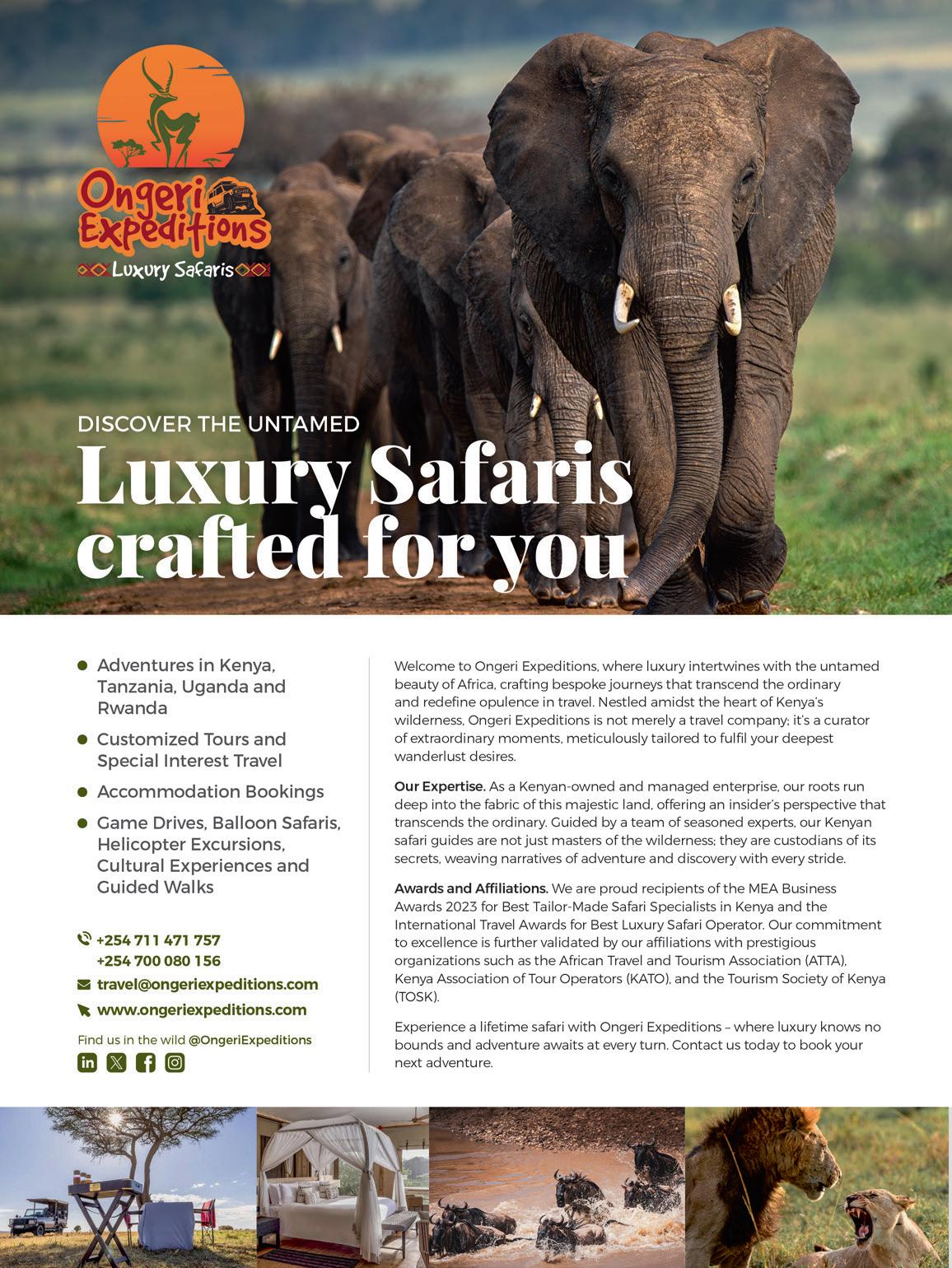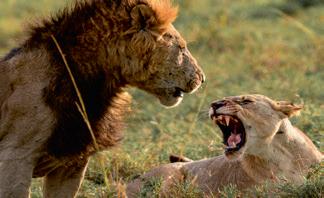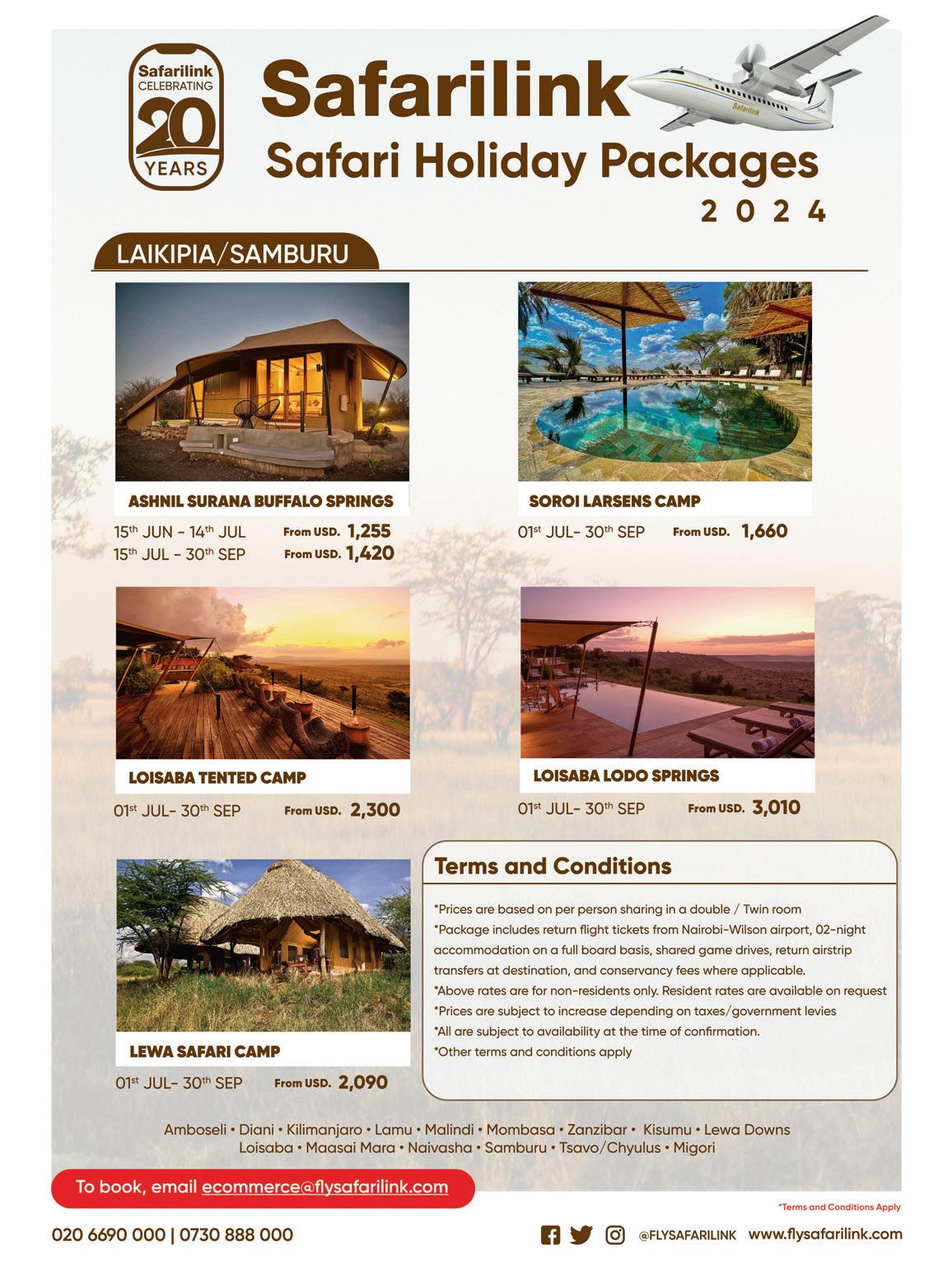WITH COMPLIMENTS OF SAFARILINK | AUGUST-OCTOBER 2024


WITH COMPLIMENTS OF SAFARILINK | AUGUST-OCTOBER 2024

WE FLY TO THE HEART OF THE WILDEST ADVENTURES
AN EXPERT GUIDE ON ROUTES TO THE TOP
THE WELLNESS ISLAND WHY LAMU IS LEADNG KENYA’S YOGA BOOM
COMPETITION PRIZE
CHANCE TO WIN STAY AT SAFFRON GARDEN

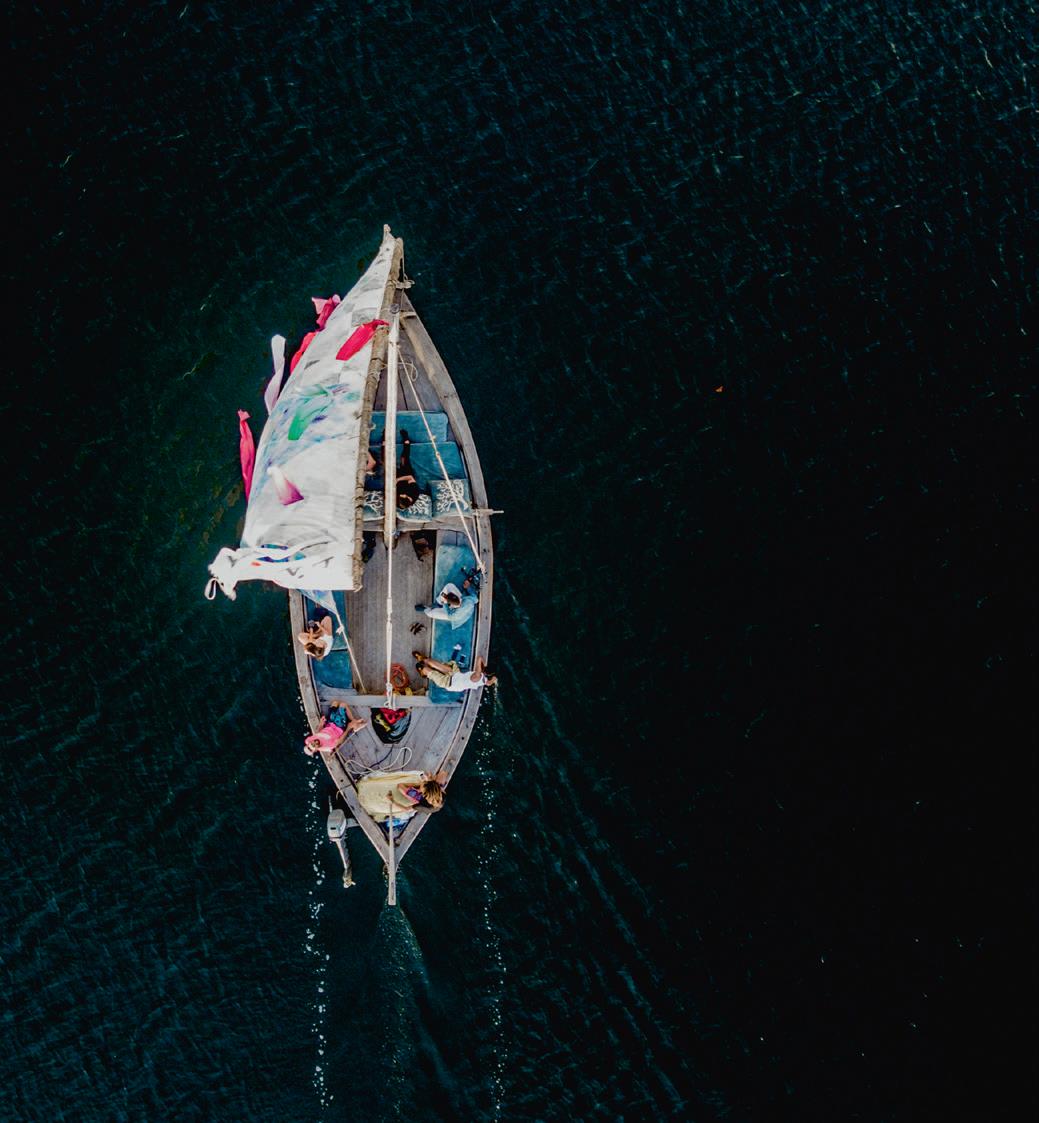

Tel: +254 20 6690000 / 730 888 000
E: res@flysafarilink.com
T: +254 20 669 0000
Media & Design House Ltd A Subsidiary of Land &
Head
Managing Editor:
E: markedwards@landmarine.com
Advertising sales:
Antony Gathi, Country Manager
T: +254 (0)721 584 465
E: antonygathi@landmarine.com
Caroline Wairimu, Sales
T: +254 (0)720 943 847
E: kenya@landmarine.com
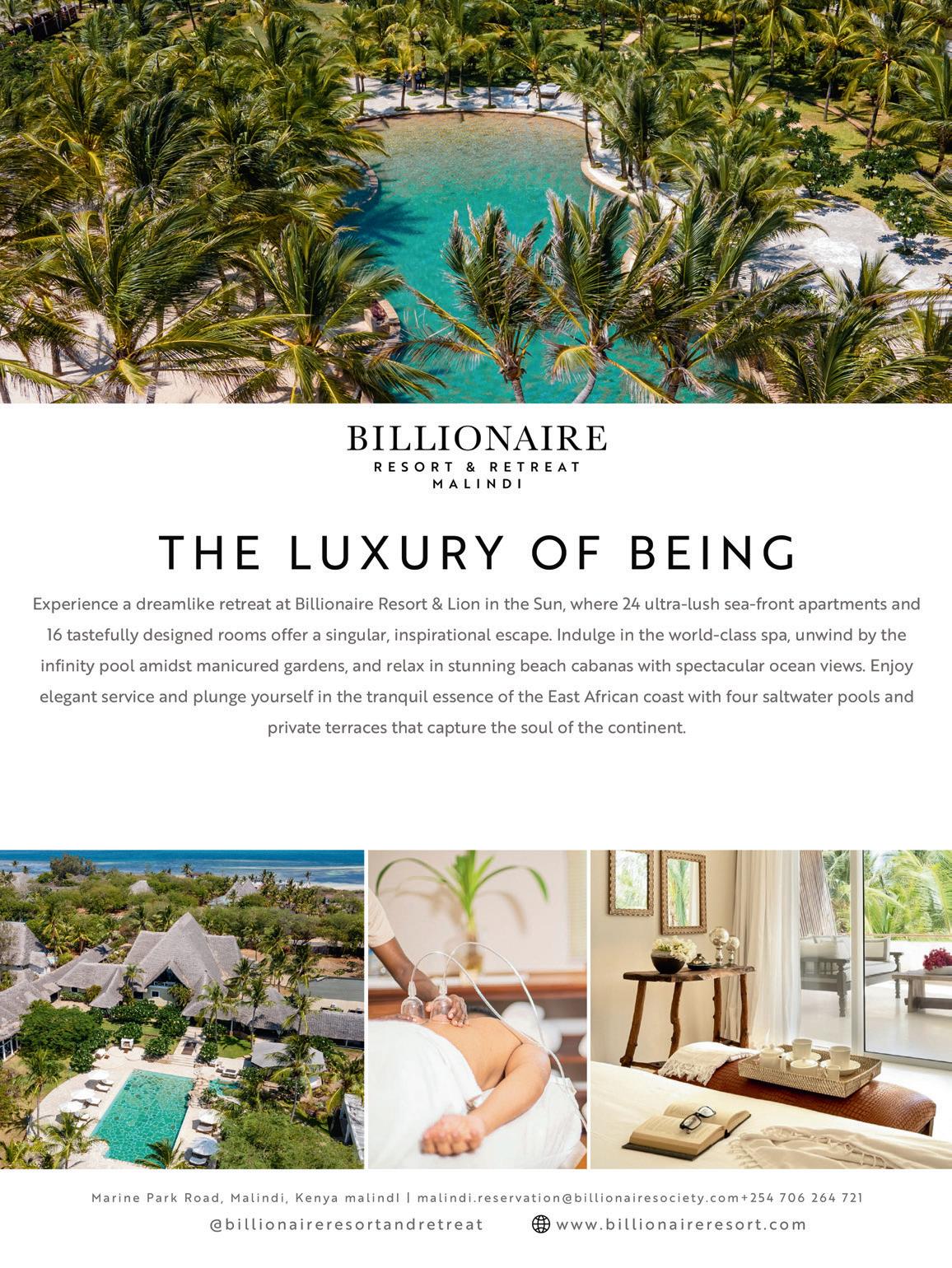
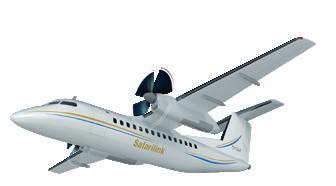

Our latest passenger figures show how we have progressed. In December 2023 alone we flew 29‚000 people to their destinations. Last year‚ Safarilink flew 360‚000 passengers.
It gives me great pleasure to welcome you onboard your Safarilink flight today and to our relaunched inflight magazine, The Link.
The magazine arrives as the airline celebrates 20 years committed to delivering exceptional air travel services. It has been a remarkable journey for us and our cherished passengers. Safarilink Aviation was launched in 2004 with just two leased aircraft that ferried 29 passengers.
Our latest passenger figures show how we have progressed. In December 2023 alone we flew 29‚000 people to their destinations. Last year‚ Safarilink flew 360‚000 passengers‚ a testament to the trust bestowed upon the airline by those seeking a journey beyond the ordinary.
To cater for increasing passenger numbers we have grown our fleet to 14 aircraft – 10 Cessna Caravans and four De Havilland Canada Dash 8s – symbolising progress and a dedication to elevating the travel experience.
Behind every successful flight was a dedicated team. Safarilink's journey involved the nurturing of a now 300-strong workforce. Each team member contributes their expertise across various roles‚ collectively steering Safarilink towards new horizons. In the spirit of corporate social responsibility‚ Safarilink is involved in sustainability initiatives extending beyond aviation. These include working with the Mount Kenya Trust on wildlife conservation and tree planting with over 60‚000 seedlings already planted.

We continue to evolve. Technological advancements play a pivotal role in Safarilink's narrative, and we continue to lead the industry in the adoption of cutting-edge technology with upcoming innovations including acquiring Cessna Caravans fitted with electric engines by 2026.
Here’s to the next 20 years. I hope you enjoy your flight.
ALEX AVEDI | CEO
In March this year Safarilink received delivery of two new Cessna Caravans. The arrival of the aircraft means Sarfarilink now boasts a fleet of 10 of the single engine turboprops. The Caravans are suited to the
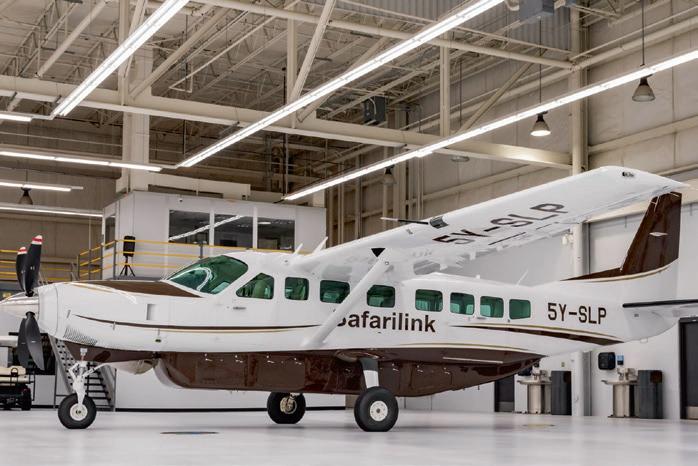
remote airstrips and short flight times that make up the majority of the destinations we serve. Their rugged fixed under-carriage aircraft that is ideal for landing on the ‘dirt’ airstrips common in game parks. Its high wings and
In June Safarilink announced it has partnered with APG East Africa on a bilateral interline ticketing agreement. This collaboration will significantly expand our airline’s distribution network, offering our customers greater accessibility and a wider range of booking options. We're confident this partnership will further enhance our ability to meet all your ticketing needs.
The Nairobi-based APG East Africa is part of a global brand with over 100 offices covering more than 170 countries. APG is the world's largest and most successful passenger and cargo general sales agent airline representation network, partnering with 200 valued airline clients.
The collaboration will facilitate seamless travel for our passengers.
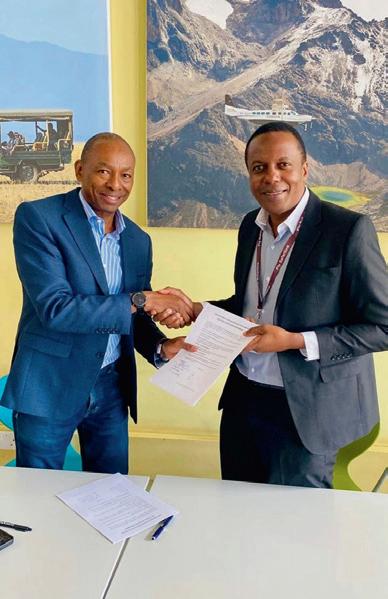
large windows allow exceptional viewing of the unfolding scenery and animals while in flight.
The full Safarilink fleet now totals 14 aircraft as we also have four twin-engine Dash 8s to fly more passengers on longer routes.
Safarilink has long been at the forefront of local aviation sustainability and ecotourism is a fast-growing market sector in Kenya, with a growing number of responsible lodges in and around the main parks and reserves. It is a great honour then that our CEO, Alex Avedi, was invited to be a panellist at this year’s Ecotourism Kenya Sustainable Tourism Forum in June.
With over 15 years of senior management experience in the aviation industry and having played a pivotal role in leading Safarilink Aviation towards sustainability, Alex brought a wealth of knowledge and expertise to the forum in discussing the topic ‘Choosing Climate-Conscious Tourism, Towards Climate-Friendly Journeys’.
For more information on the event, visit ecotourismkenya.org
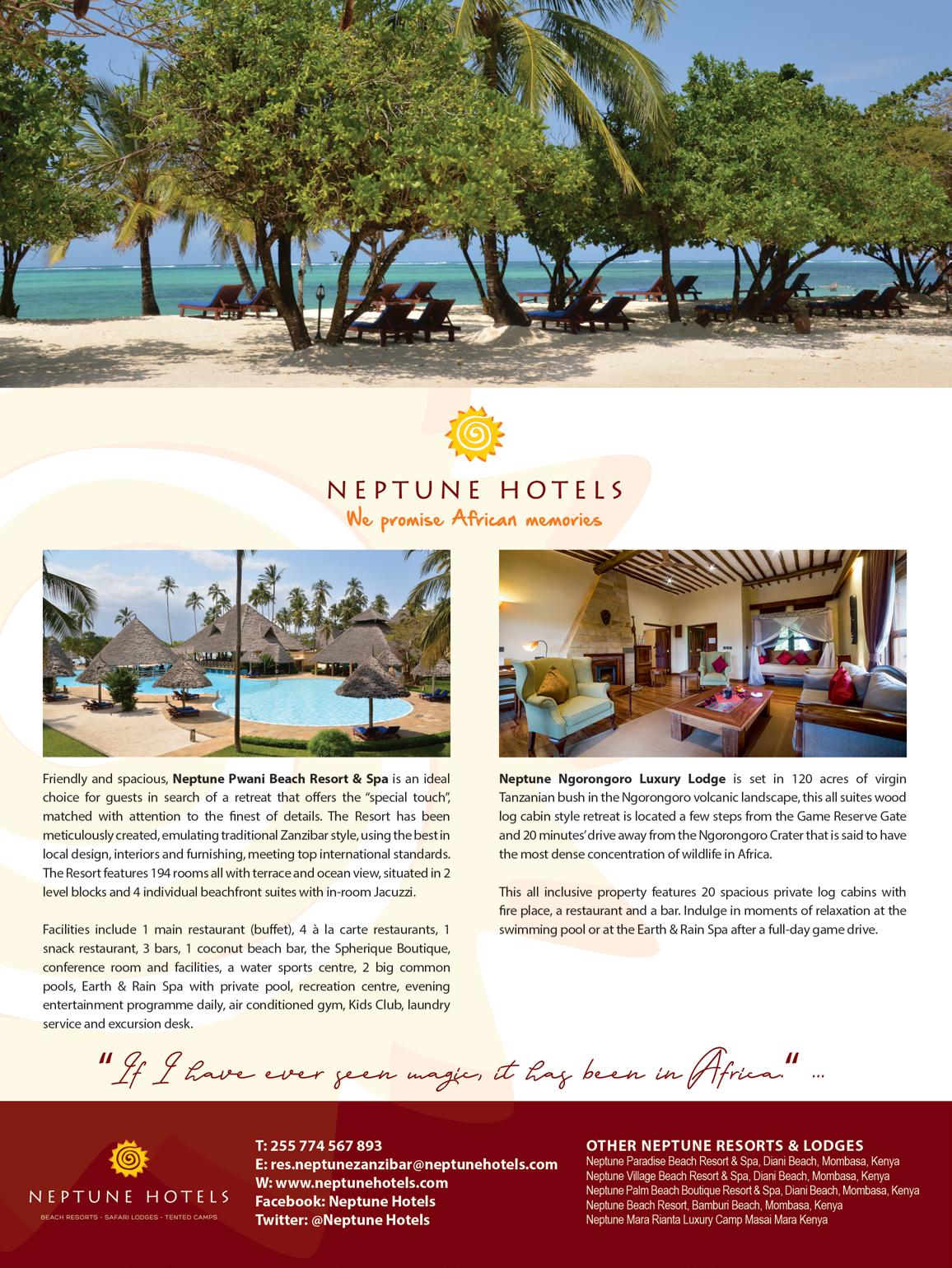
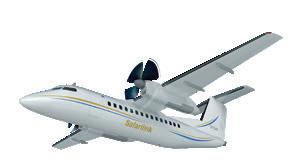
Airline cabin crew play a vital role in ensuring passengers enjoy their time in the sky and Safarilink prides itself on the expertise of its inflight team. Here, Cabin Crew Supervisor Lilian Wandera talks about her role and her lifelong ‘passion for the sky’.
Yesterday, Lilian Wandera was in Diani on the Kenyan coast and this evening she is flying to Kisumu on the shores of Lake Victoria. Such is the jet set life of a Safarilink flight attendant.
Lilian is living her dream. “I have always had a passion to work in the sky,” she says. She attended university in Nairobi and her parents had hopes that she would pursue a career in journalism, but Lilian says: “I’m happy that I made this choice. I am excited to come to work each day. Every day is a new experience. Working in the cabin crew at Safarilink is an exciting and challenging experience which also requires a high degree of responsibility and specialisation to ensure the safety and comfort of our passengers.”
Kitale-born Lilian has always loved to travel. Even when she has time off from work,



A LOT OF PEOPLE WHO HAVE A TRADITIONAL MENTALITY THINK WE ARE THERE TO LOOK BEAUTIFUL, THAT WE HAVE NO BRAINS AND JUST MAKE TEA AND COFFEE IN HIGH HEELS. NOW PEOPLE ARE STARTING TO UNDERSTAND HOW IMPORTANT OUR ROLE IS.

she is exploring. “There are so many beautiful places driving distance from Nairobi. I just get in the car and go.” She is especially excited when her Safarilink flying timetable includes a night’s stopover in Diani on the Kenyan coast. “I was built for the beach,” she says. “I love the tropical weather. It gets me relaxed. We get a hotel room and a chance for a calm, relaxing and beautiful time.”
Lilian has flourished at Safarilink since she joined as an intern in 2013. “I then joined the check-in team for nine months before I got an opportunity to be trained for cabin crew 2014.” Five years later Lilian was appointed Cabin Crew Supervisor. “I am in charge of all cabin crew staff,” she says. “I work under the chief pilot advising them in terms of development and recruitment. I am also in charge of the in-house cabin crew training that we run at Safarilink including drills in preparation for emergencies. It is vital our cabin crew maintain and reflect the standards of the company and our brand.”
Lilian’s rise through the ranks is testament, she says, to Safarilink’s culture of prioritising employee growth. “Safarilink is big on internal upgrades,” she says. “It gives staff an opportunity to grow. I’m very grateful. I have been supported

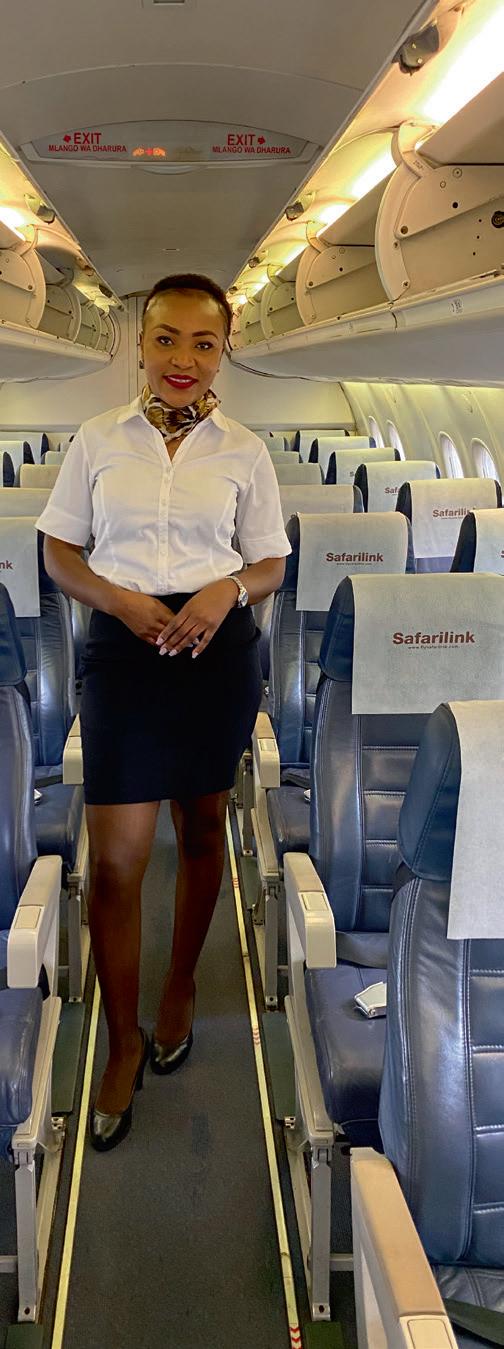
every step of the way and without them I wouldn’t be where I am. As the airline is growing, its employees grow with it.”
Lilian – who loves to cook in her spare time – now leads the cabin crew six-week course that she went through herself as a trainee. Safarilink prides itself on its exemplary levels of safety and service and while most cabin crew trainees come in through aviation colleges, the airline has its own specific training programme in place to maintain those standards. “It begins with 21 days of ground training,” says Lilian. “This includes initial safety and emergency training, fire-fighting drills, smoke drills and ditching [landing in water] drills and proficiency check. Then the recruit will have around six to eight flights for service training.”
To excel as a flight attendant, Lilian says you need to be a team player. She heads a 22-strong cabin crew collective and it’s important they all work as one. “Teamwork makes the dream work. You also have to be a good communicator, have strong customer service skills and be safety conscious. It’s also important to be adaptable. Your hours can change with early or late flights.”
The long and irregular hours can be a challenge. Lilian admits the role doesn’t give her much time to be with her family, who live a seven or eight-hour car journey away in the town of Kitale in the northern Rift Valley. “It can be difficult to be away from family. After my flight, I have office duties to carry out so I am very busy.”
There’s a lot more to being a cabin crew member than many people are aware of. Lilian says it can be challenging to change the perceptions of those who have no idea of
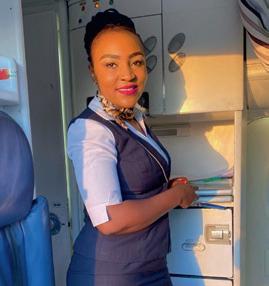
their many responsibilities. The job does have a glamorous image and while Lilian says there are many perks, she is keen to dispel the myth that the job is frivolous and all about appearance.
“A lot of people who have a traditional mentality think we are there to look beautiful, that we have no brains and just make tea and coffee in high heels. Now people are starting to understand how important our role is. We are safety officers. I am a safety officer. Safety is the number one priority.”
Lilian praises the positive support system that is place at Safarilink but advises young Kenyans considering a career as cabin crew to be ready to work hard. Do that and the rewards are immense.
“I would encourage people if they have a passion for flying, but it requires a lot of dedication and discipline. There is the opportunity not just to grow in travel miles but culturally. Airlines are a global platform connecting the world. You need to understand your passengers. If you have that passion for the sky and dedication it will get you a long way.”
For more information on how to become part of the Safarilink cabin crew team, head to the careers page on our website at www.flysafarilink.com/en
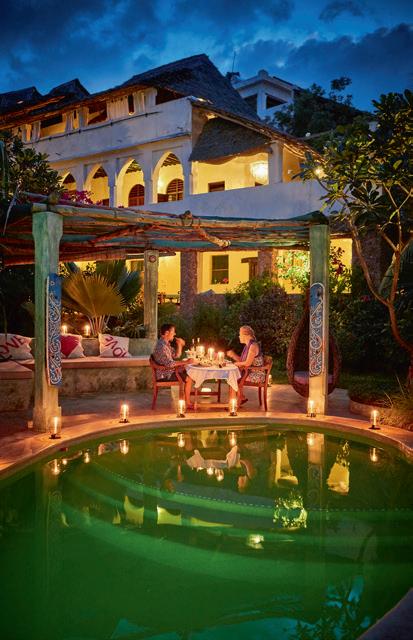

With its deserted beaches, car-free roads and its simple, natureconnected way of life, Lamu offers visitors an ideal off-grid escape from the stresses of daily life. No surprise then that the island is at the forefront of Kenya’s thriving wellness tourism industry. Monika Fauth, the founder of the annual Lamu Yoga Festival, reveals how the island’s “natural wellbeing” has helped her – along with thousands of visitors – on a transformational journey of self-discovery. Mark Edwards reports.


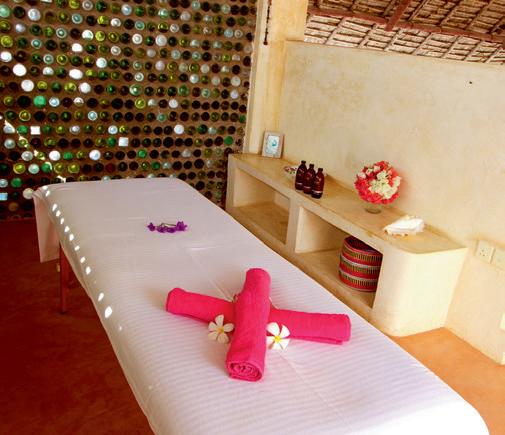
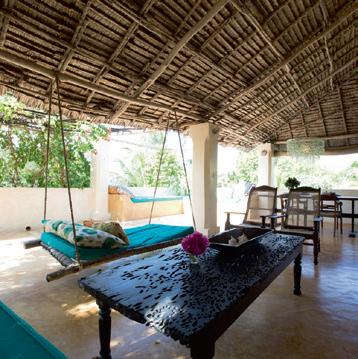
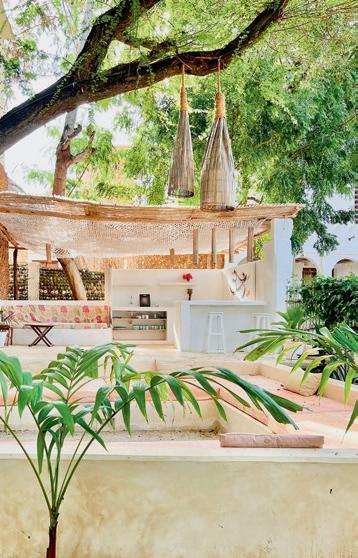

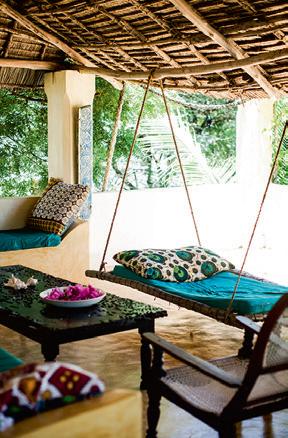
It is little surprise that Lamu’s secluded setting and the captivating simplicity of life here has made it a detox destination for visitors stressed out by the pressures of modern living. Monika Fauth – who has called the island home for the past 25 years – terms the slow, mindful and mystical rhythm of Lamu life as “natural wellbeing”.
She says: “With no cars comes no air pollution or sound pollution. There is also no light pollution, so we have beautiful skies. We are surrounded by the powerful energy of the ocean. You walk barefoot here, and life is 24 hours outside. The people are extremely friendly. Everything runs ‘pole, pole’ [‘Slowly, slowly’ in Swahili]. Life here is very organic and natural. The food comes from the sea or on land from fresh fruits and vegetables.”
When Netherlands-born Monika first arrived in Lamu she was in her early 30s and had established a career as a fashion buyer. While she still loves fashion to this day, the peace and tranquility of the island brought an inner understanding that seemed at odds with couture’s fixation on outside appearance.
“When I landed in Lamu I started to do yoga on the beach,” she says. “My life felt much richer, living in this present moment, in reality. So, I have been practicing since that moment almost every day. I have become a teacher and I have done lots of other wellness programmes. It really has changed my life. I followed my heart and I never looked back.”
Making the decision to stay in Lamu, Monika channeled its peace and happy isolation into a series of wellness ventures. In 2014 she launched the Lamu Yoga Festival, a five-day annual event of workshops and classes that has gone on to attract hundreds

of wellness practitioners and devotees from Kenya and beyond. Prestigious US publication Yoga Journal named it among its ‘Top 11 International Yoga Festivals Worldwide.’ She also runs retreats – most of them based in Lamu’s small, stunning coastal village of Shela at the 16-room Banana House and Wellness Centre, which Monika set up with her islander husband – his name is Banana –more than two decades ago.
“Lamu is an amazing place to connect with nature and oneself,” Monika says. “Walking on an unspoiled beach at sunrise or sunset where there are no sunbeds or big hotels in sight and just the sound of the ocean and the wind. You can also feel that connection walking in silence over the dunes, swimming through the mangroves or meditating in a

We are surrounded by the powerful energy of the ocean. you walk barefoot here and life is 24 hours outside. The people are extremely friendly. Everything runs 'pole, pole'
traditional dhow on the ocean. You don’t even need a boat. Floating in the water of a small channel in the mangroves and letting the outgoing tide at new moon or full moon take you towards the open ocean is an experience you will never forget.”
The natural therapy of Lamu works in tandem with the teachings of Monika and the international team of experts. The festivals and retreats have become sanctuaries for the stressed out. “We get visitors from all over the world,” says Monika. “They are talking about the same issues: our health, our wealth and our relationships. We have people come with stress, burnout, autoimmune illnesses – it
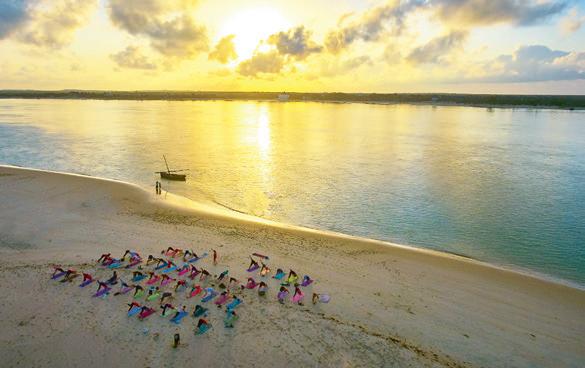
can be difficult to find answers about our wellbeing and health. Lamu can help people slow things down and become more interested in the being than the doing. You learn how to handle stress, increase your energy, improve your sleep, have a healthier and happier life.”
Monika can attest to the healing power of the practices. Her island life may seem idyllic to the outsider, but there have been challenges. Some of them very serious indeed. She has two sons with Banana. When the youngest, Karim, was two and half years old he fell ill with a fever. At the time her husband was in the Netherlands taking his citizenship exams so Monika made the decision to take her son to a hospital in Nairobi. Here, medical staff told her that Karim had a virus that had reached his heart. They would have to operate immediately, or he would not survive.
Post-surgery, while Monika was at his bedside, Karim suffered a stroke that left him unable to walk or speak. In the coming months, Monika cared for her newly disabled son, but she admits she was “more surviving than living my life”. A friend who had noticed her struggles, recommended she take the Art of Breathing course, which teaches deep breathing habits for wellness, energy and mood. “The six days of that course changed my life,” says Monika. “I still use those
Lamu is an amazing place to connect with nature and oneself. Walking on an unspoilt beach at sunrise or sunset with... just the sound of the ocean

techniques and now I am a qualified teacher of the course on my retreats. It has helped me manage my life. Having a smile on your face when things are easy is easy, but when things are difficult, and you can still smile – that is the art of living.”
Thankfully, Karim has made an amazing recovery and lives a full life. He can now walk and talk and works in the Netherlands on an organic farm. He still has his health challenges, but copes with them in a mindful manner that, Monika says, “inspires people”. Now in his early 20s, Karim had his first epileptic fit at the age of nine. As more seizures followed, it became apparent that stress and anticipation of future events was a trigger for the attacks. “Now, he lives only in the present moment,” Monika says. “He has been my blessing and my teacher. He surprises me with his wisdom.”
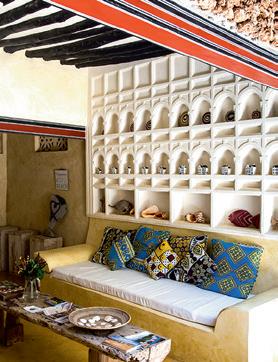
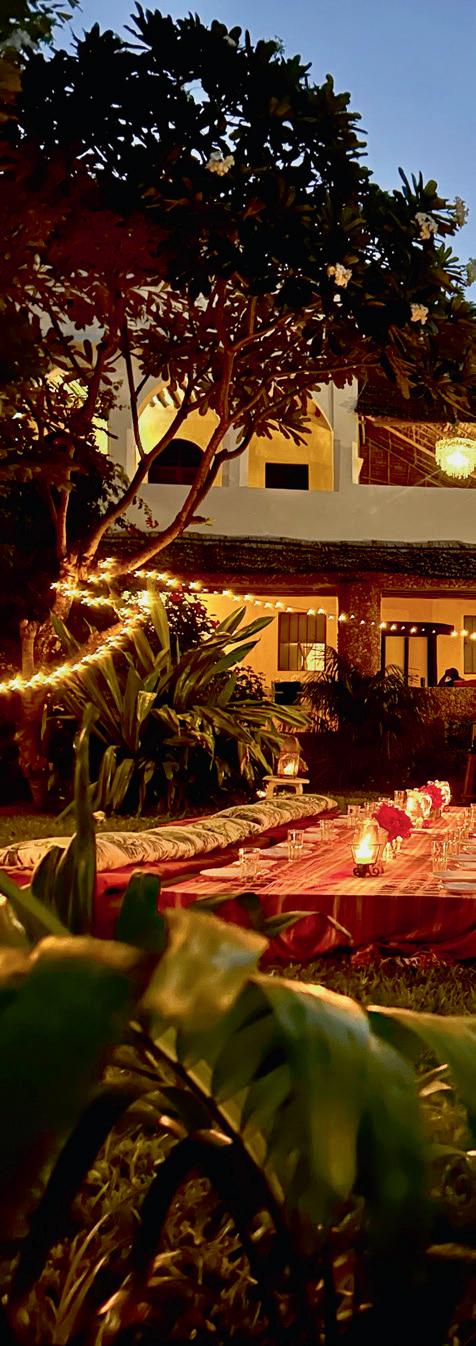
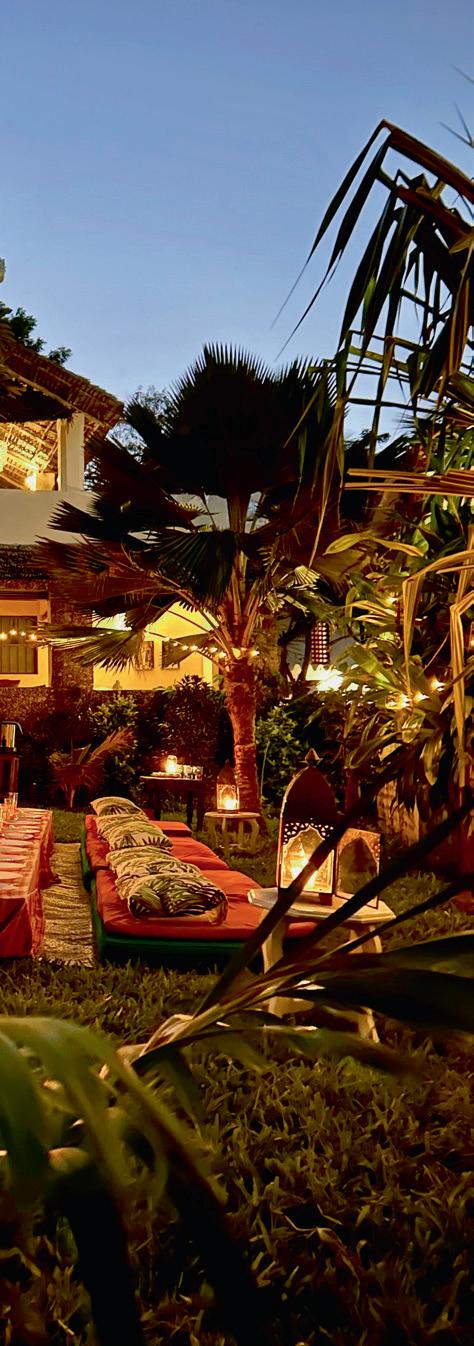
Following her heart and being open to what is happening around her has also helped Monika navigate life’s ups and downs. She and Banana are no longer together, Karin spends much of his time in the Netherlands and her oldest son, Jamil, has been studying in Costa Rica and the Netherlands so Monika has spent plenty of time alone on Lamu. She has focused on her spiritual growth in solitude, endeavouring to learn from the challenges. At the start of this year Monika delved deep into her internal journey in a series of six podcasts under the title Build Your Soul Story. In conversation with podcast host Raf Stevens, Monika says: “A lot of people hide behind the pain. Pain is painful, but also powerful. Freedom is within us, happiness is within us.”
An important part of cultivating that free and easy happiness, Monika says, is to be generous in spirit. She cites the Lamu Yoga Festival as an example, which was launched not as a business venture, but rather a gift to the island’s tourism industry, which, in 2014, was in a slump after a series of security threats on the Kenyan mainland. “I followed the maxim of invest in bad times. I thought the festival would help lift our spirits up and give us the tools to handle ourselves in difficult situations. I was promoting Lamu island as the perfect wellness destination in East Africa.”
Now Monika is preparing for this year’s festival. The event is marking its 10-year anniversary and will run from October 30 to November 3 with more than 150 workshops on offer across 15 venues on the island. The bigger-than-ever festival will now look to promote the whole of Kenya as the perfect country for wellness and enlightenment.
“We are working with the Kenya Tourism Board Magical Kenya to promote the country as a wellness destination,” Monika says. “Kenya
has it all – amazing nature, a lot of therapies, a lot of retreats. If we focus together on wellbeing it is an amazing growing industry.”
Monika has passed on the daily running of Banana House and Wellness Centre to Jamil. Having grown up on the island and travelled extensively, his local knowledge and worldliness make him hugely popular with locals and guests alike. “He was born and raised in Shela so he has a deep connection with the community. He’s also quite adventurous so if guests want to explore the island, go fishing or try some stand up paddleboard yoga, he is there.”
Beyond the mother-son connection, Monika says Banana House is “one big family”. “Our staff is growing with us. The people who helped build it have stayed on and got jobs as room staff or cooks. It’s a very conducive atmosphere for those who want to feel at home. Our guests can also take part in Swahili cultural projects such as cooking classes and community Swahili dinner every week. It is a truly authentic experience.”
Now she’s sharing the workload with others, does Monika have plans for more ventures? She lets me know that she won’t be busy just for the sake of it. ‘Pole, pole’ Lamu Island has taught her that.
“When I moved to Lamu 25 years ago, people would always ask me what am I going to do there and I replied: ‘I’m a human being, not a human doing.’ Over the years I have built up a business, I started the festival. The doing was strong. I am really happy I have embraced the human being.”
To book your ticket for this year’s yoga festival, visit lamuyoga.org For a place to stay, visit bananahouse-lamu.com
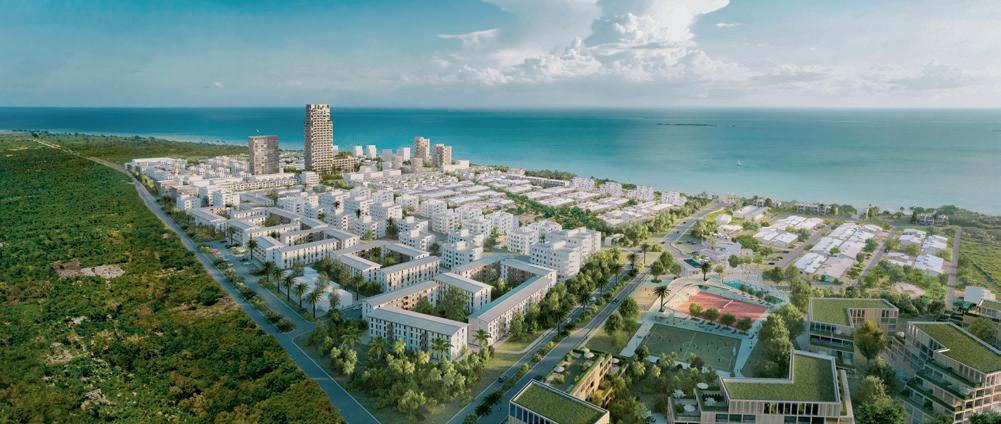
Why the size and structure of Burj Zanzibar –set to be the world tallest timber tower in the world – could be the secret to the island’s sustainable success.
The Fumba Peninsula is a 14km by 3km promontory south of Zanzibar’s capital flanked on both sides by pristine coastline. Sebastian Dietzold compares it in size and shape to the island of Manhattan in New York.
The urbanisation of Fumba over the past decade – overseen by the German-led engineering firm CPS Dietzold founded with his wife, Katrin – has advanced the similarity. Launched in 2015, Fumba Town is Zanzibar’s first eco city with already over a thousand state-of-the-art apartments and villas housing a cosmopolitan community supported by on-site

schools, universities, shops, health centres and even an organic food delivery service.
If Fumba Town is Zanzibar’s Manhattan, then the Burj Tower looks set to be its Empire State Building. At 96 metres in height, the 27-storey timber tower will be an iconic addition to the Fumba skyline. Dietzold describes the development – which will include a Canopy by Hilton luxury hotel on the first six floors, topped by 187 sea-view apartments and topnotch amenities throughout – as Fumba Town’s “flagship building”. Currently all that exists are some mouth-watering artist’s impres-


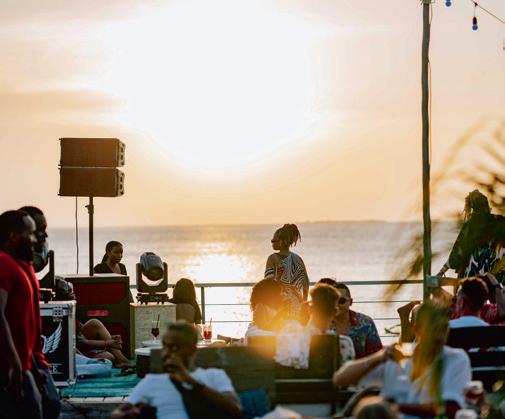

sions of the tower – including its ultra-luxury penthouse suites with roof gardens and spectacular public spaces such as the roof bar, pool and gym – with the ground-breaking ceremony scheduled to take place early next year and completion anticipated in 2028.
Already the building’s headlining height has attracted global media attention. If Burj Zanzibar was built today it would be the tallest timber tower in the world.
The scale of the Burj and the natural materials used to build it
are integral to the Dietzolds’ vision for sustainable urban development in Zanzibar and beyond.
“The tower will be our landmark,” Dietzold says. Not because it’s a glamorous highlight but because it will promote responsible, sustainable buildings and trigger a whole new industry in Tanzania, from agroforestry to the production of engineered wood products.”
“The Burj Zanzibar tower is part of our mission to meet the massive housing demands in Africa in a responsible way. We want to support a technology that protects our planet.”


Tanzania has one of the fastest rates of population growth in the world with the number of citizens projected to reach 100 million by 2035. That’s more than a 50 per cent rise on the current figure. When working with mother nature, Dietzold believes high rise buildings can be the answer.
“60,000-plus new homes are needed in Zanzibar Town over the next 15 years,” he says. “Space is limited on Zanzibar. We have to go up.”
The Zanzibar government is aware of the housing shortage and gave permission to CPS to create an inclusive urban development.
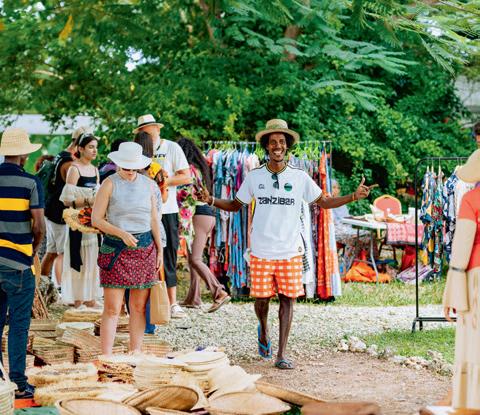

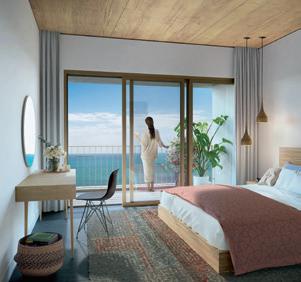
Across its 149-acre site that fringes 1.5km of coastline, Fumba Town is already more than a third of the way towards building 5,000 units with the emphasis of the last stage of development – known as Phase 3 – on more high-rise properties with Burj Zanzibar at the pinnacle.
“Fumba Town has been designed for two to three million people in the long run,” Dietzold says. “Phase 1 began with two-storey buildings, now there are three-storey and four-storey buildings. Phase 3 will be predominantly high-rise and will give the development more of a city character.”
As well as the raised height of its new buildings, Fumba Town is featuring increased use of cross-laminated timber (CLT). Dietzold describes it as “the concrete of the future” and is so sold on its benefits that when we connect on Google Meet for this interview, he appears on my screen from the office of his timber-built villa in Fumba Town where he lives with his family. “We feel like this is home now,” he says.
CLT is an engineered product consisting of layers of wood boards stacked in alternating directions and glued together. The result is a solid, durable panel that has the load-bearing qualities of concrete, without its heavy carbon footprint. Conventional concrete

construction is responsible for around a quarter of global CO² emissions while CLT absorbs carbon during the building’s lifetime. Measures that can stem the march of climate change on the fragile ecosystem of Zanzibar Island are crucial. Building a sustainable future here is a goal shared by CPS and the Zanzibar government. Currently, the wood is sourced from Austrian spruce forests and fabricated as CLT panels in the same country by Binderholz, a global leader in timber construction.


MEASURES THAT CAN STEM THE MARCH OF CLIMATE CHANGE ON THE FRAGILE ECOSYSTEM OF ZANZIBAR ISLAND ARE CRUCIAL. BUILDING A SUSTAINABLE FUTURE HERE IS A GOAL SHARED BY CPS AND THE ZANZIBAR GOVERNMENT.



The panels are then shipped to Zanzibar where they are kitted together Lego-like by local construction company Volks. house. Dietzold is proud that the 160-strong Volks.house team is predominantly made up of neighbouring villagers trained to assemble the timber-based homes in super quick time.
“We have moved from construction to production,” he says. “Our mass-made timber homes are an important development if we are to keep up with demand.”
The team’s work is so finely tuned now that its latest project, the three-storey timber homes that make up Fumba Town’s new Vizazi collection, was completed in just seven weeks earlier this year.

“We have around eight years’ experience with timber homes,” says Dietzold. “Our team is becoming internationally recognised for its expertise. We have had recent requests from German buyers wanting to make use of our workforce.”
These smaller projects are priming the team for the big one: Burj Zanzibar. The design by OMT

architects features timber columns and beams as well as cross laminated timber slabs to form the tower’s honeycomb-like outer structure. This will be built around a steel-reinforced concrete tube at its centre.
The inclusion of conventional materials at the building’s core is to ensure all required fire and life safety standards are met. While there are all-timber towers in Norway – including the 85.4-metre-high current record holder in Mjøstårnet – and Switzerland, they are not permitted in Zanzibar.
While he accepts the ruling, Dietzold points out that CLT is renowned for its inherent fire resistance.
“It’s funny that people think timber is more combustible, but it is the opposite. Engineered timber structures are safer than concrete – we know how they react under fire. We have been working with [fire safety service] Ingnis running thousands of fire tests. If you heat timber walls to 1,200º they just crust and that crust is a heat insulator – the temperature doesn’t rise more than 10 degrees inside.”
Dietzold adds that CLT remains structurally stable when subjected



to high temperatures and – fond as he is of a Big Apple-analogy – he references one of the most tragic moments in New York’s modern history to power his point: “If the World Trade Centre was a timber construct it would not have crashed to the ground.”
The chance to own a part of such an iconic building and to enjoy elevated living has meant apartments in Burj Zanzibar are selling fast. Dietzold says over half of them have already been snapped up. As with the rest of the Fumba Town development, buyers and investors have proven to be a cosmopolitan crowd. “We have had buyers from around 60 countries, including the US and UK” Dietzold says. “Many are Africans. Zanzibar is a safe haven on the continent and now you can get residency for US$ 100,000.”
The majority, though, are Tanzanians with Dietzold saying it was always in the CPS plans to target the country’s rising middle class with their pricing. Apartments in Fumba Town start at just under US$ 38,000 while you can get a studio in Burj Zanzibar from US$ 108,442.
The influx of these young professionals is helping to build a vibrant culture in Fumba Town. The fine homes are attracting fine minds. Last year the Indian Institute of Technology opened its first international branch in Fumba while the eco city is also home to the African
School of Economics, which has 5,000 students.
“There is a culture of innovation growing. Fumba is transforming. We are trying to make a change here,” says Dietzold.
The Burj is a symbol of that change, but I ask Dietzold whether any of the early Fumba Town residents are concerned that their homes will soon be in the shadow of a gigantic neighbour.
“There has been some criticism, but most people are excited,” he replies. “Everybody who bought into Fumba knew this was growing community and it would evolve over time. The Burj is already attracting investment and all Fumba homes are appreciating in value as a result.”
With residents onboard with the changes charted for Fumba Town, the city moves forward with the sustainable future of Zanzibar at its heart. Construction of the Burj will require a huge increase in timber, which CPS is hopeful it can begin to source from Tanzanian forests. “It will simulate a lot of investment in the Tanzanian timber industry,” says Dietzold. “Tanzania has huge pine forests in the south. Pine is fast-growing so you can sustain the lumber stock for a long time and create a circular supply chain.”
The CPS website singles out a forest development in central Tanzania near Iringa. Its size? Twice that of New York.
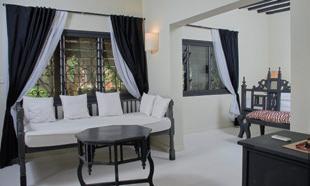
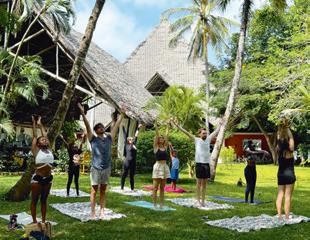
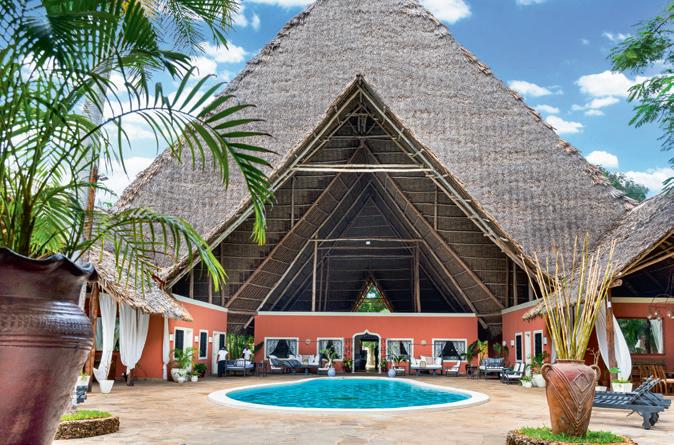
Step into Saffron Garden for a transformational retreats. Located in the heart of Malindi – one of the most magical places on the Kenyan Coast – the boutique hotel's 15 carefully decorated bungalows are nestled in a 5-acre oasis. Saffron Garden beautifully blends nature, gastronomy, art, and tradition, creating a unique haven. This eclectic space has become the ultimate gathering spot for travelers seeking peace of mind, enjoyment, and engaging activities in Malindi and beyond.
We are honoured then that Saffron Garden has generously offered an amazing competition prize for The Link’s launch edition. One lucky reader will win a two-night stay at Saffron Garden for themselves and a guest of their choice. They will also be treated to an outdoor movie night with dinner during their stay.
To be in with a chance of winning this amazing prize, email your answer to the question below along with a photograph of you holding Issue 1 of The Link on your Safarilink flight to competition@landmarine.org
Bahati njema!
Question:
Which coastal town in the Kenyan Riviera is Saffron Garden located in?
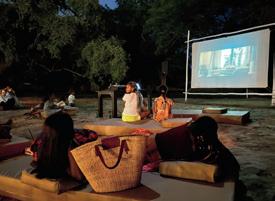
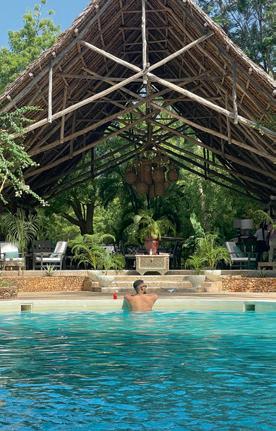
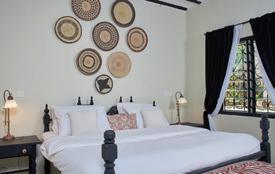
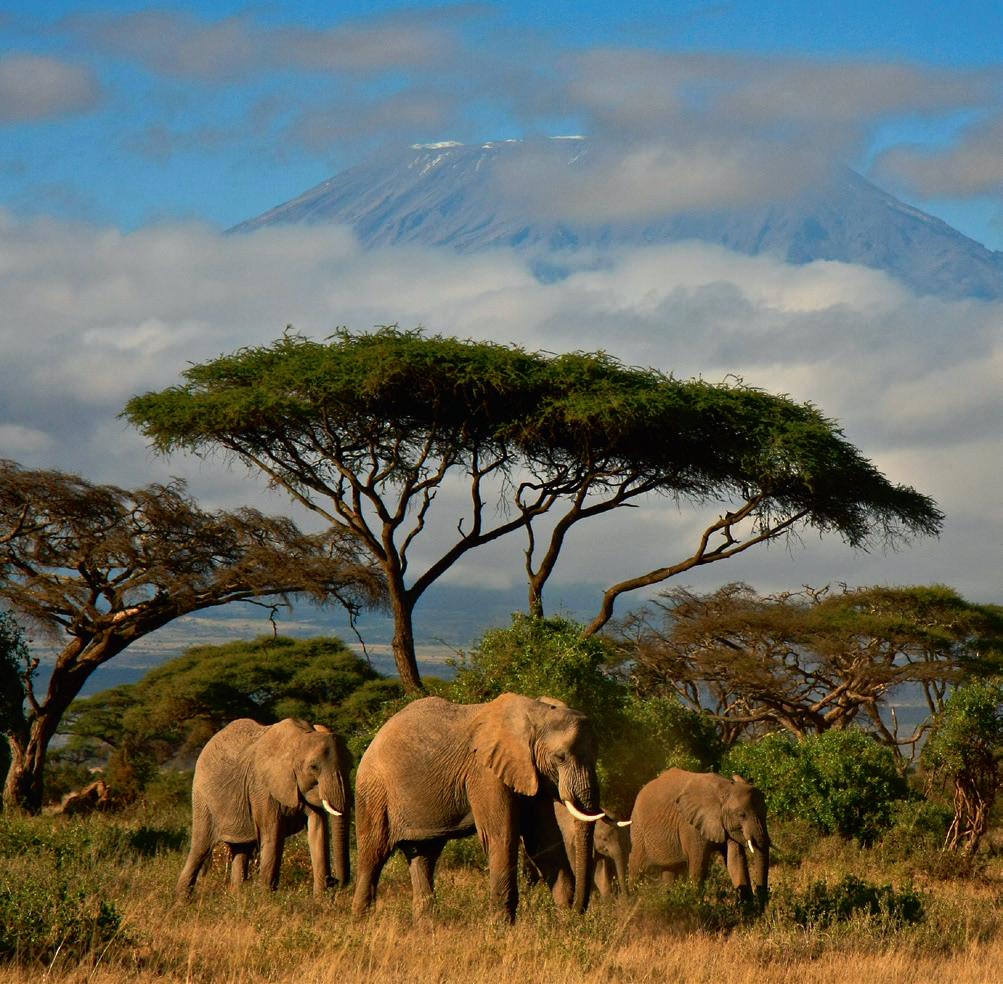

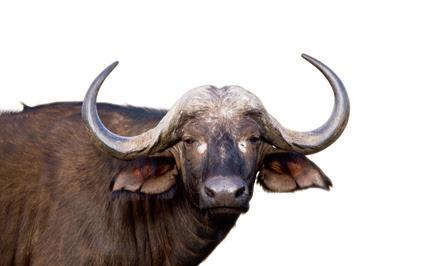
Safarilink takes you into the heart of Kenya and Tanzania’s world-renowned wildlife wonders. With impressive landscapes, remote escapes, tribal cultures, unforgettable animal experiences and high-adrenaline adventures there is always a perfect national park for everybody’s tastes. Here’s our guide to help you decide which destination is right for you.

For those who want to see large herds of elephants up close…
This popular Kenyan national park is known as the ‘land of the giants’ because of its large herds of elephants, which includes a population of super tuskers (elephants with one or both tusks weighing over 45 kgs). These magnificent specimens – given names to match their imposing size such as ‘Big Tim’, ‘One Ton’ and the rather more prosaic ‘Craig’ – are sadly the target for trophy hunters but protected Amboseli remains a safe haven. The national park is an unforgettable place to see these giants in the wild with the Kenyan view of Mount Kilimanjaro providing a spectacular backdrop. Other large herbivores that call the park home include Cape buffalo, impala, Maasai giraffe, gerenuk, Grant’s zebra, gazelle and wildebeest while carnivores such as lion, leopard, cheetah, spotted hyena, jackal and civet are also on the prowl here.
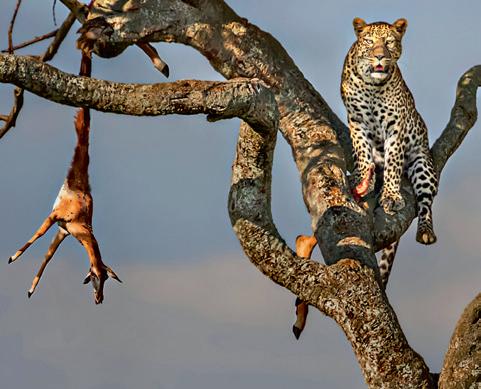
An integral part of Kenya’s oldest and largest national park, Tsavo West volcanic soil supports a variety of habitats for magnificent game viewing with good numbers of rhino, lion, cheetah, leopard and buffalo as well as diverse plant and bird species including the threatened corncrake and near-threatened Basra Reed Warbler. That volcanic soil is responsible for some of the park’s most singular attractions such as its red elephants –actually they just appear red due to constantly dust bathing in the fine red volcanic soil here – and the hippo and croc-filled Mzima Springs. The source of the springs is a natural reservoir under the Chylulu Hills to the north where rain percolates through the volcanic lava rock before emerging decades later at Mzima. This natural filtration process is the reason for Mzima’a famously clear waters, which have become a habitat for hippos and crocs while the surrounding date and fig trees are a source of food for vervet monkeys and a plentiful bird life. A true oasis.
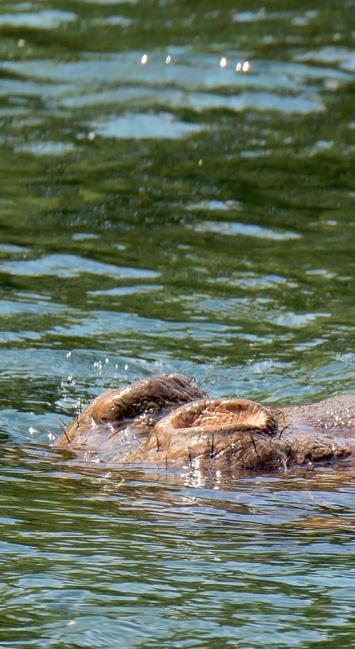
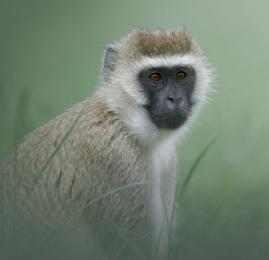
For nature at its most merciless and dramatic…
Close to a quarter of Kenya’s wildlife is found in the Masai Mara National Reserve with large populations of lion, cheetah, elephant, African buffalo and rhino among its hundreds of animal and bird species. Many of these animals coalesce in the never-ending journey that is the Great Migration. Large herds of wildebeest, zebra and other antelope species or migrate north into Masai Mara from the neighbouring Serengeti National Park in Tanzania. For many, the most dramatic stage is when the wildebeest fling themselves from the steep banks of the Mara River. It is a perilous undertaking. Should the wildebeest survive the Mara’s strong currents and preying crocodiles, there are a host of hungry big cats awaiting them on the other side. This crossing usually occurs at Mara River around late July to August and is an unmissable safari experience.
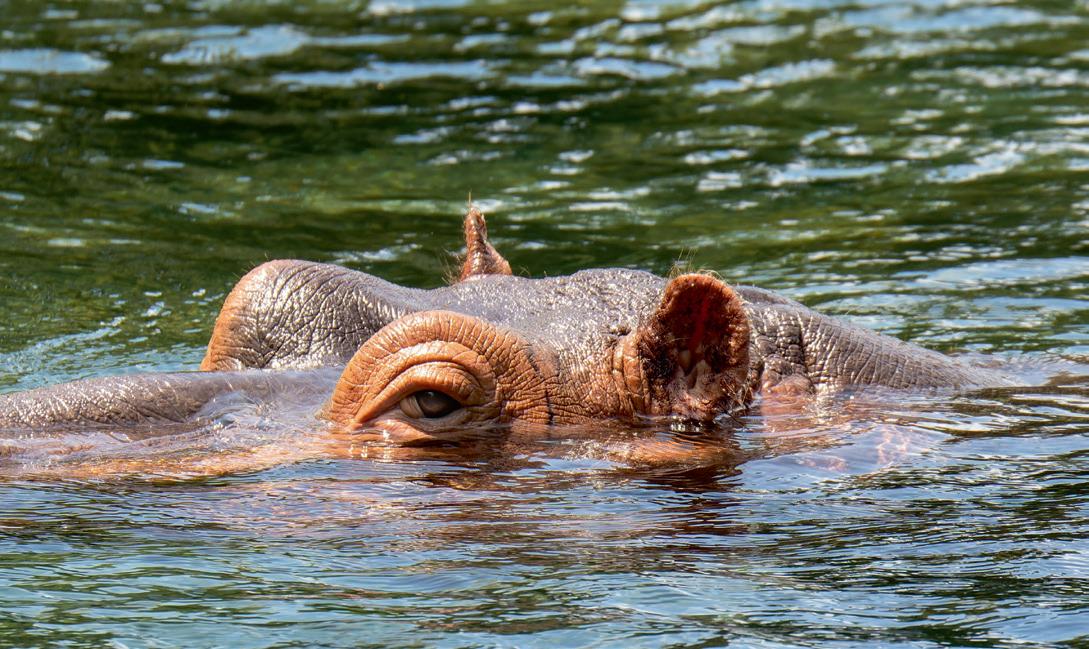
(Connect via Masai Mara with our partner airlines)
The Serengeti, which was added to the Unesco World Heritage List in 1981, has been described as the ultimate safari destination. Its endless plains are home to all of the Big Five while researchers have found the national park still has the highest number of globally threatened animal species like black rhino, wild dog, cheetah and elephant. The park’s headliners, though, are its lions. Nowhere else in the world has more of the big cats – more than 3,000 at last count – in its ancient ecosystem. The Serengeti’s landscape provides sheltered vantage points for these predators with plenty of kopjes – granite rocks – that provide ideal hunting and hiding grounds. Lions will loom wherever the Great Migration goes.
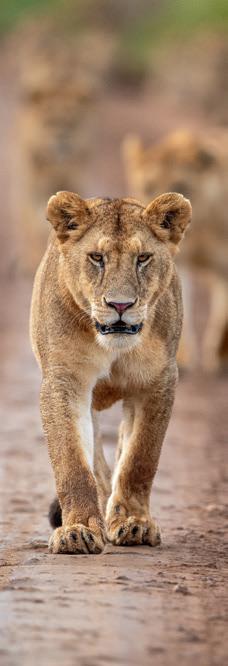
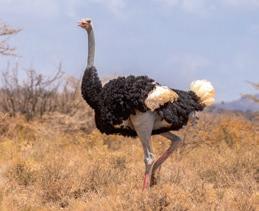
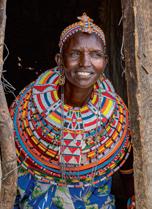
If you are a seasoned safari enthusiast, then you may want to head north of Laikipia to one of the less-visited regions in Kenya to experience the ‘Samburu Special 5’. This collection of rare species – Beisa Oryx, reticulated giraffe, Somali ostrich, Grevy's zebra and gerenuk – make their home in the diverse ecosystem of the Samburu National Park. These animals have adapted to the arid terrain here and are an unforgettable sight for visitors. The park is also the traditional homeland of the semi-nomadic Samburu tribe, known for their colourful clothing, hairstyles and strong sense of warriorhood. Music, singing and dancing are important elements of their culture, and can be experienced at the annual Lake Turkana Festival.
Heading for tourist hot-spots on your vacation may seem a good ideaonpaper,butyou’llgetadeeperconnectiontoKenya(orany other destination) away from the crowds and the cliches. Here are just some of the advantages of taking the path less trodden.
If you really want to immerse yourself in the rhythms of life in the place you are visiting, spend time with the locals. Zanzibar offers
some fascinating opportunities for this. Hang out with the Mombasa youth swimming by the historic Leven House. In Nairobi head to Uhuru Park at the weekends where
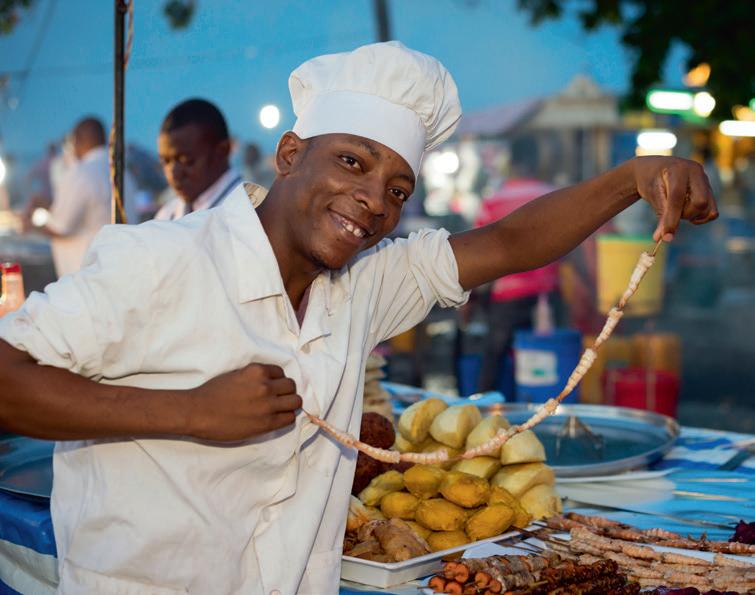
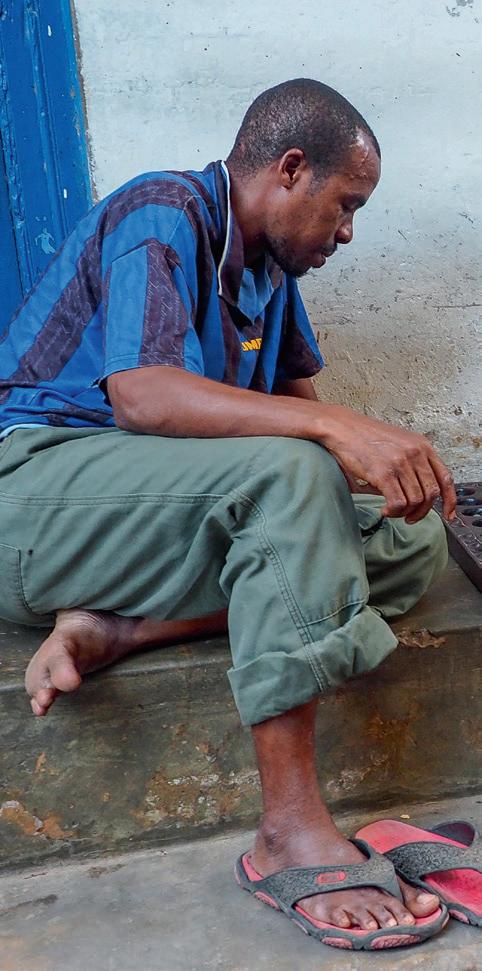
crowds of locals enjoy their free time. At night, check out the capital’s thriving music and club scene at venues such as Alchemist that attracts an equal mix of expats and Nairobians dancing the night away. If you’re strolling the beaches in Lamu look out at low tide, you will likely see locals searching rock pools carrying a spear. Unless you’re an octopus, there’s nothing to be alarmed about. During a single low tide, a skilled octopus hunter can spear more than 10 of the slimy invertebrates, which thrive amid the maze of rocks and are a delicacy on the islands. When you are exploring, get a local to be your guide. Whether it is a Maasai
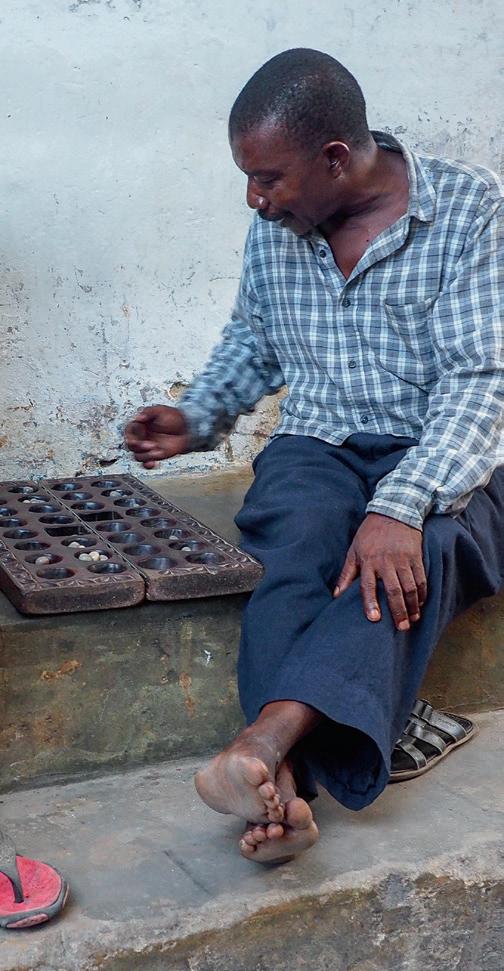
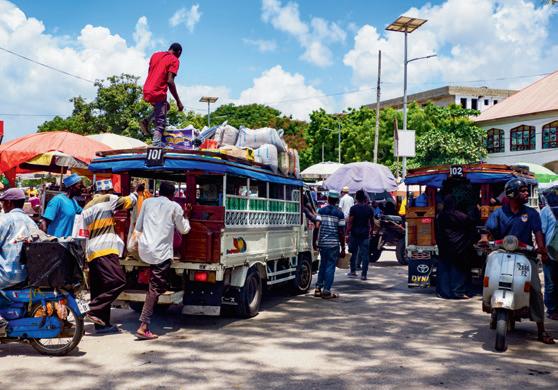


TAKING PHOTOGRAPHS ON HOLIDAY IS A GREAT WAY TO HOLD ONTO MEMORIES, BUT IT IS POSSIBLE TO GET CARRIED AWAY, BELIEVING THE KEY TO MAKING GREAT, LASTING MEMORIES IS TO MAKE PHOTOGRAPHS OF EVERYTHING AND EVERYONE.

your destination and soak up the noise and life going on through the windows. Part of the joy of Kenya’s oldest city is get lost in its circuitous streets and stumbling upon hidden gems. You could also hire a bicycle to explore Hell’s Gate National Park and trace its dramatic Rift Valley landscape.
guide navigating you through a national park wildernesses, a local showing you the secret spots of a historic port town or a fisherman taking you out on his dhow to one of the islands, there is much insider information to be gleaned.
As well as meeting the locals, why not seek out ways to empower them? That could be by supporting local businesses with your souvenir purchases or joining in on initiatives that maintain the environment you have enjoyed during your stay. There are regular beach clean-ups organised along the Kenyan coast. They are

an opportunity to get some exer cise, meet new friends and leave a place you love even better than you found it. It may even inspire you to return for a longer stay as part of volunteer programme. Volunteer World is always looking for Ocean Clean-Up and Marine Education Assistants – applicants must be 14 years old and above – to work in Kenya. Your help will make a difference and once your work is completed, you’ll get an official letter of thanks from Unesco, which will look great on your CV.
Firing up Google Maps will get you to your destination via the quickest route, but the joy of the journey will be lost head down in your phone. Our dependence on technology and gadgets can blind us to the beauty of life in the moment. Far better to be guided by chance and instinct. So, jump on a packed dala dala to
Visiting Kenya is a sensory experience and tasting from its vibrant food scene provides real insight into the culture here. Swahili cuisine creates flavoursome magic from the islands’ wealth of spices and fresh seafood so indulge yourself. There are food tours in Nairobi as well local villages that give you the chance to lend a hand in preparing local dishes. Street food is hugely popular here. The capital’s CBD is the place to get a taste of street food scene with opportunities galore to taste test chapati, mandazi and plenty of sizzling barbecued meat (nyama choma). Be curious and ask questions and you’ll get a true taste of Kenya.
Keeping your holiday experience as authentic as possible starts with your accommodation. You may have good intentions of pursuing a free-range experience
while away, but if you are staying in a resort packed with tourists that is going to be tough. Best then to look for accommodation in districts that are primarily residential areas. They will be cheaper, will present far more opportunities for interaction with the locals and no crowds pursuing a generic tourist experience.
You don’t need to get fluent in Swahili before you arrive, but learning some key phrases –hello, please, thank you, goodbye, sorry – will be welcomed and break the ice when speaking to the Kenyans you meet. Apps such as Drops or Duolingo both have Swahili among the languages they teach and make learning fun and easy. Bahati njema!
7
Get a slice of Kenya as a souvenir
If you are going to avoid the generic trappings of tourism that should extend to the souvenirs you buy as holiday keepsakes. Bringing home a tea towel, a fridge magnet or a key ring might be traditional, but you can do much better. Necklaces and bracelets made of beads have a special significance to the Maasai people, who use different colours and combinations to symbolize power, beauty and love. The best way to buy Maasai beads
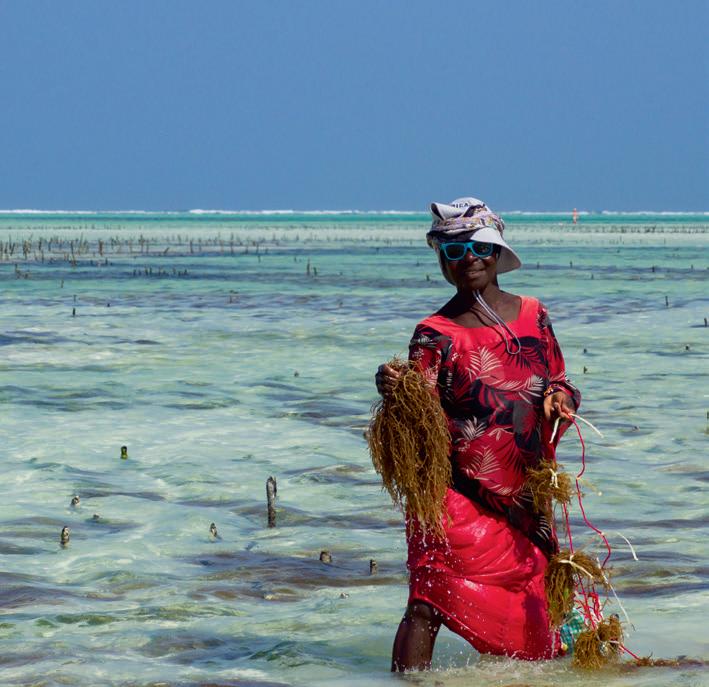
is directly from the Maasai people.
If you’re joining a safari, you’ll likely visit the Maasai Mara Game Reserve and the resident Maasai tribe. In the city, the best place to get beads is the Kazuri Bead Factory, located in Mbagathi Ridge. As well as beads, the factory sells handmade ceramic products. They
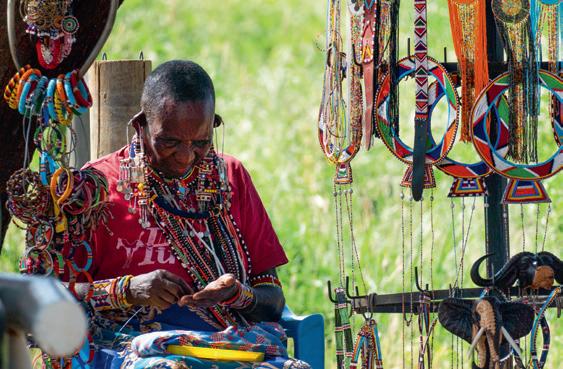

also have an outlet in the Westgate Shopping Centre in Nairobi.
8
Don’t photograph your holiday away

Taking photographs on holiday is a great way to hold onto memories, but it is possible to get carried away, believing the key to making great, lasting memories is to make photographs of everything and everyone. Consequently, tourist hotspots are often a mass of selfie taking. However, being present in the moment and absorbing our experiences has been proven to fix them in our memories far better than mindless camera clicking. Best to make each picture count and put some thought into each one. To ensure your holiday snaps are to be treasured forever, you can book a tour with a professional photographer who will offer tips on best capturing the spectacular scenery of the Kenyan coast.
Kenya has some of the best beaches in Africa. From pristine vanilla-sand hideaways to laidback surfing hangouts, we’ve selected some classic coastal resorts.
With 17km of soft white sand, lapped by calm azure waters and all framed by forest, Diani has a strong claim for being the best beach not only in Kenya, but also the entire continent. Indeed, it has been voted Africa’s Best Beach at the World Travel Awards a record five times. Coral reefs protect the beach from heavy surf, creating perfect conditions to swim, snorkel or to try windsurfing. When you need to refuel or quench your thirst there are plenty of beachside bars and cafés to sample. Even after sunset (spectacular here), Diani has plenty to offer after dark with some of Kenya's best coastal nightlife to enjoy until the early hours.
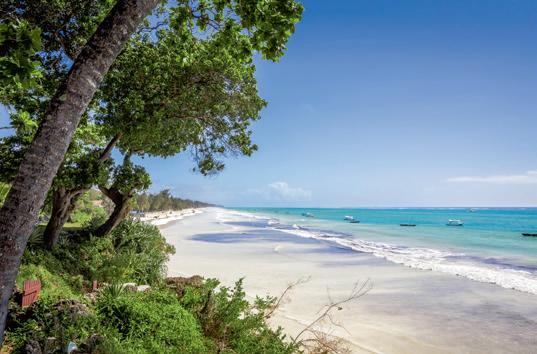
The beach is only 30km from Moi International Airport in Mombasa, which we fly to every day. Safarilink also flies to Diani from Nairobi’s Wilson Airport.
As well the beach itself offering the sight of black and white colobus monkeys in the treetops, Diani also offers wildlife adventures at the nearby Shimba Hills National Reserve. You can also try out a range of adventure sports with kitesurfing, skydiving and deep-sea fishing all available.
Whether you’re a backpacker on a budget or wanting to splash the cash on a luxury stay, all are catered for in Diani. One of the most elegant beachfront options is the Maji Beach Boutique Hotel (the-maji.com) a Swahili-style mansion that enfolds a wonderful pool and gardens.
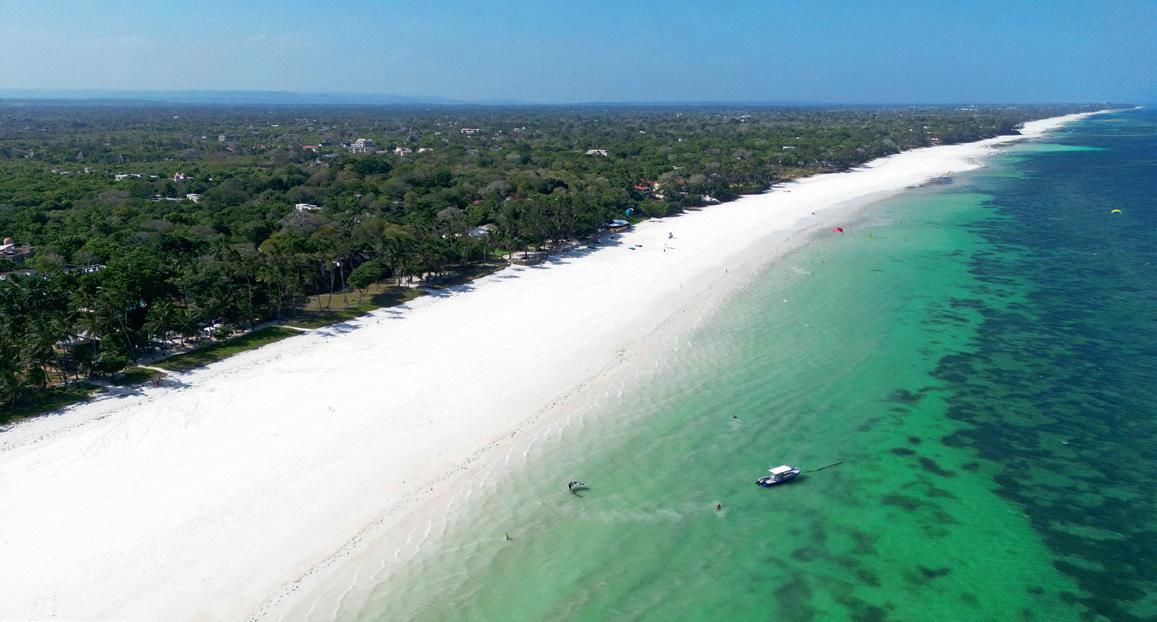
Another unspoilt gem that few beyond the most avid of Kenyan beach lovers are aware of. A short drive north of Malindi in Kilifi County lies the village of Mambrui. Here you’ll find a wide expanse of golden beach backed by banks of sand dunes – a rare sight on the coast. This is Kola Beach. Tourists are few here, in fact the only regular visitors are the steady offshore winds that create fantastic conditions for kitesurfing. It is also a great spot for deep sea fishing and Malindi Marine Park is close by with its pristine reefs ideal for snorkelling.
GETTING THERE:
We fly every day to Malindi International Airport from where Kola Beach is about a half-hour drive north along the coast road.
BEYOND THE BEACH:
You could link a beach break here with a safari adventure at Tsavo National Park, which is about a five-hour drive inland. Here you’ll find elephant, rhino, hippo, lions, cheetah and leopard across plains in the shadow of Mount Kilimanjaro.
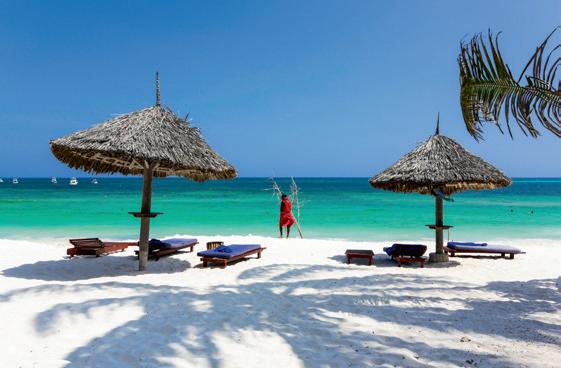
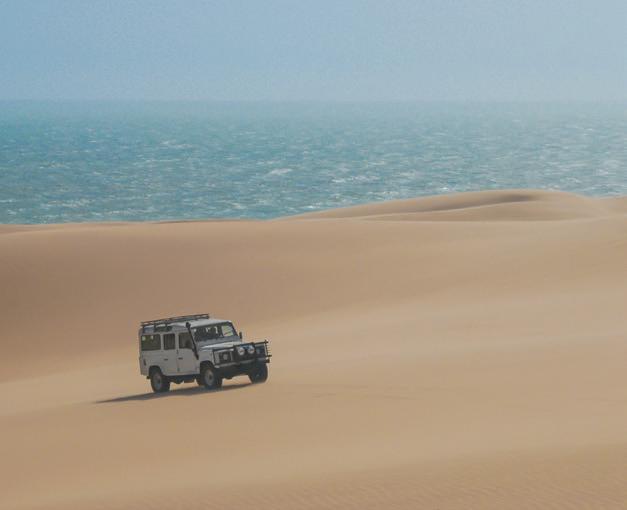
WHERE TO STAY:
Kola Beach Resort (kolabeach.com) is an attractive collection of villas moments from the ocean and with a bar, restaurant, conference facilities, three pools, gym and spa.
The village of Watamu has become the epicentre of ecotourism in Kenya with a host of hospitality options promoting a footprint-free stay amid the village’s necklace of pristine beaches, rare wildlife and protected marine reserves. Watamu is actually a series of beaches set around cerulean coves on the sandy peninsula that separates the protected mangrove ecosystem of Mida Creek from the Indian Ocean, but if we had to pick one, it would be Jacaranda Bay – a 10km stretch of bone-white sand and crystal waters, which is also home to some of the best restaurants and resorts in the area and offers plenty of opportunities for water sports such scuba and snorkel, kite- and windsurfing, sailing and deep-sea fishing.
Watamu is a 30-minute taxi journey south along the coast from Malindi International Airport.
Watamu has a deep cultural heritage. You can visit the stone ruins of the town of Gedi, which in the 13th century was an important settlement for the maritime spice trade between East Africa and the Middle East. Also close by is the Arabuko Sokoke Forest Preserve, a protected area which is home to animals such as elephant, antelope and its namesake the Sokoke wildcat.
The Watamu coastline is dotted with chic retreats, but special mention goes to Lonno Lodge with its boutique collection of eight beachside rooms and suites. All have wonderful ocean views, but the huge 72 sqm Top Tower Room with its private and exclusive roof-top terrace is our pick.
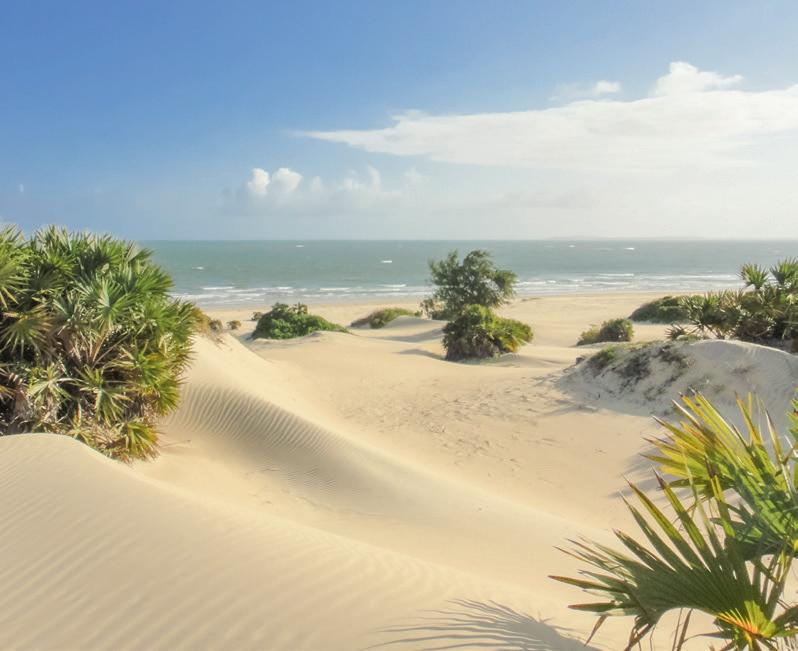
SHELA BEACH
Most people head to Lamu Island to visit its Unesco Heritage Site Old Town, which is the oldest and best-preserved Swahili settlement in East Africa. However, it also offers a bohemian beach idyll in Shela in the south-east corner of the small island. Here you’ll find a laidback and artsy community, including many expats, that has settled around this beautiful and barely touched beach. Everything moves at a stately pace here, except the wind that can really whip up and coupled with the lack of barrier reef means this is one of the few places along the coast with decent waves for surfing.
GETTING THERE:
We fly to thge islandf of Lamu every day. From there it is around 3km to Shela.
BEYOND THE BEACH:
Lamu Old Town is a living museum of Swahili culture. Life among its ornate inner courtyards, verandas, and elaborately carved wooden doors has gone one mostly unchanged for centuries with around 6,000 donkeys still the only means of transport here.
WHERE TO STAY:
To soak up the heritage of the island, stay at the Kijani Hotel (kijani-lamu. com/), a traditional Swahili villa in Shela village with 11 individually designed rooms and a lovely rooftop restaurant.
GAZI
If the crowds at Diani do not appeal, continue south towards the Tanzanian border and you’ll come across this almost deserted gem. Gazi is a secluded stretch of sand that slips under the radar of most beach lovers. Here, a forest of palm trees gives way to an unspoilt expanse of beach with calm waters sheltered by the off-shore Chale Island. You’ll be all alone in your personal paradise.
GETTING THERE:
We fly to Diani twice daily. From there it is about a 30-minute taxi drive south along the coast road fo Gazi. We also fly each day to Mombasa from where it is about a 90-minute drive.
BEYOND THE BEACH:
At the north end of the beach at the jaw-droppingly beautiful Gazi Bay there is a mangrove forest that can now be navigated along the Gazi Women’s Mangrove Boardwalk, a community-based project that protects this valuable yet delicate ecosystem. Women from Gazi village manage the site and provide guided tours of the mangroves as well as a restaurant serving freshly caught fish.
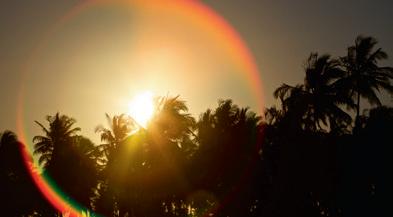
WHERE TO STAY:
For accommodation that blends in with the pristine surroundings, head to Cove Treehouses (covetreehouses.com) on the far side of the mangroves from Gazi village. Here you’ll find six self-catering villas nestled in a picturesque cove.
Procrastination is a struggle for many, sapping productivity and often leading to feelings of anxiety and worthlessness. But, help is at hand. Social entrepreneur and author Jackline Christopher Mjema shares some strategies on how to ditch the delay tactics and unlock our true potential.
Procrastination is a common struggle that affects individuals across various aspects of life, hindering productivity and preventing the realization of goals. However, by understanding the underlying causes and implementing effective strategies, we can overcome procrastination and unlock our true potential. In this article, we will explore practical techniques and mindset shifts that can help us beat procrastination and pave the way for increased productivity and success.


Setting clear, specific, and realistic goals is key to combating procrastination. Break down larger goals into smaller, manageable tasks and prioritise them based on importance and deadlines.

To effectively combat procrastination, it is crucial to identify its root causes. Procrastination often stems from factors such as fear of failure, lack of motivation, overwhelm, or poor time management skills. By pinpointing the underlying reasons behind our procrastination tendencies, we can develop targeted strategies to address them.
Setting clear, specific, and realistic goals is key to combating procrastination. Break down larger goals into smaller, manageable tasks and prioritise them based on importance and deadlines. By having a clear roadmap, we reduce ambiguity and create a sense of purpose, making it easier to act and avoid procrastination. Establishing a structured routine can significantly help in overcoming procrastination. Designate specific times for different tasks and activities, including breaks and relaxation. Following a routine creates a sense of discipline and minimises the temptation to procrastinate.
Effective time management is crucial for beating procrastination. Utilise proven techniques such as
the Pomodoro Technique (25-minute stretches of focused work broken by five-minute breaks)kor the Eisenhower Matrix ( dividing your tasks into four categories: the tasks you’ll do first, the tasks you’ll schedule for later, the tasks you’ll delegate, and the tasks you’ll delete). Break tasks into smaller, manageable chunks and set specific deadlines to create a sense of urgency and accountability.
Perfectionism often fuels procrastination as individuals get stuck in a cycle of overthinking and fear of not meeting their own high standards. Overcoming perfectionism involves recognising that perfection is unattainable, and that progress and effort are more important. Embrace a growth mindset, focus on continuous improvement, and allow yourself to make mistakes along the way.
Building self-discipline and motivation is crucial for combating procrastination. Set up a reward system to incentivise completing tasks and meeting deadlines. Break tasks into smaller, more manageable parts to maintain momentum and a sense of progress. Additionally, find sources of inspiration and motivation, such as visualising the

benefits of completing a task or seeking support from an accountability partner.
Get rid of distractions:
Distractions, both external and internal, can significantly contribute to procrastination. Minimise external distractions by turning off notifications, creating a clutter-free workspace, and using productivity tools to block access to time-wast-
ing websites or apps. Internal distractions, such as negative selftalk or wandering thoughts, can be addressed through mindfulness techniques like meditation or journaling, which help improve focus and concentration.
One of the most effective strategies for beating procrastination is simply acting. Start with small, manageable tasks that require minimal effort and build momentum from there. By taking the first step, we break the cycle of procrastination and create a positive feedback loop that fuels motivation and productivity.
East African holiday itineraries often bookend bush safaris with a beach break to wind down after the animal adventures. However, time on the coast here can bring its own submerged safaris with an array of incredible marine life to be discovered on scuba dives or just snorkelling. The Link takes a deep dive to reveal some stars of the sub-aquatic world.

Swimming with dolphins is on many people’s bucket lists and if you are out in a small boat virtually anywhere off the coast of East Africa then there is a good chance you will see these mentally sharp mammals swimming off your bow. The coastal waters of Kenya, Tanzania and Zanzibar are an all-year-round home to pods of bottle-nosed, spinner and humpback dolphins. Early mornings are the best times to see them as once the heat of the day builds up dolphins dive out of sight to cooler depths. So, most dolphin tours to viewing hot-spots such as Diani Beach and Watamu as well as Kizimkazi and Nungwi in the Zanzibar archipelago set off soon after dawn. Bottle-nosed dolphins are the most plentiful and playful of the dolphins here and chances are good you’ll hear the tell-tale clicks and squeaks that announce their presence and be able to leave the boat and snorkel alongside them. Make sure you choose an ethical dolphin tour in which the boat doesn’t get too close to the animals or tries to pen them in. The waters are their world after all.
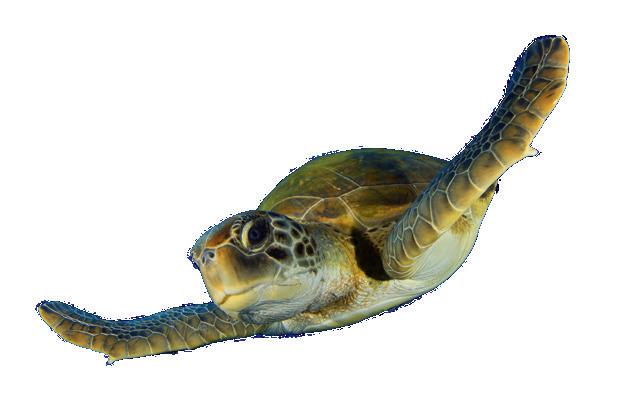
There are seven species of marine turtles in the world and five of them – the olive ridley, loggerhead, hawksbill, leatherback and green turtles – can be found along Kenya’s and Tanzania’s Indian Ocean coastline. The most widespread is the green turtle, which is named after the colour of its cartilage rather than its heart-shaped, mostly brown shell. It is also the largest with some males getting to 130 kg in weight and measuring 1.5 metres. Surviving to reach such adult dimensions is not an easy task with threats including man – they are poached for meat and shells and can get caught up in fishermen’s nets or discarded plastic in the ocean – and all manner of beach predators when they are hatchlings. The Sea Turtle Conservation Protocol and you’ll find conservation projects to protect hatching sites in marine reserves in Watamu, Diani and Lamu. Zanzibar is very keen to keep its turtle population and the conservation message is spreading among its fishermen and tourism industry. Leading the way is the Mnarani Natural Aquarium, in Nungwi on the northern coast of Unguja, which rescues injured turtles and vulnerable hatchlings, caring for them in a large seawater pool before returning them to the sea.
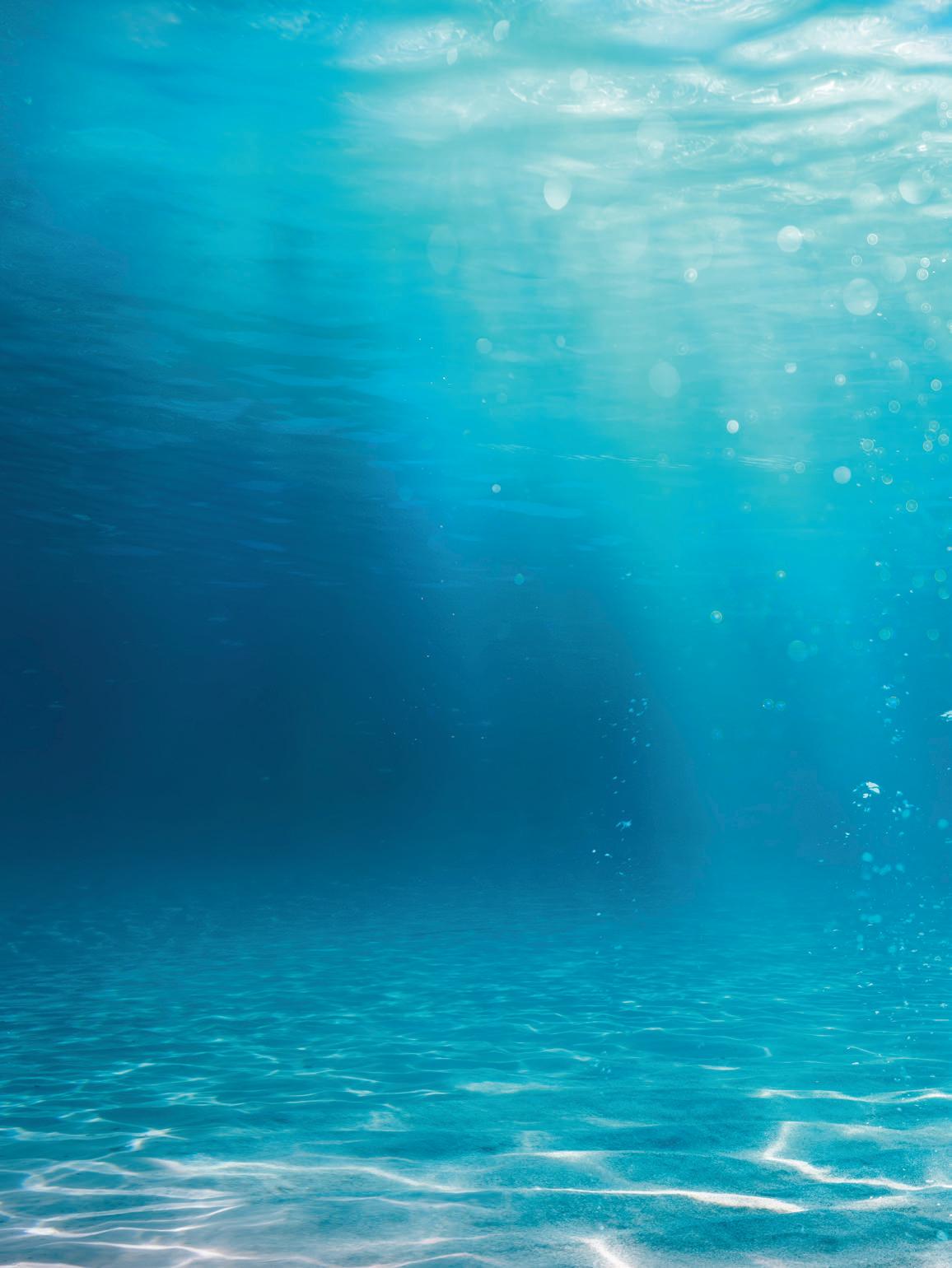
Seahorse
Seahorses can be seen in East African waters from March to June mainly in shallow tropical and temperate water where they can be found in sheltered areas such as seagrass beds and coral reefs. They are the sweethearts of the sea, mating for life and with couples swimming together with their tails entwined. In modern parlance, male seahorses are the ‘woke daddies’ of the ocean as the species is one of the few on Earth in which the father carries the unborn young. They have few natural predators thanks to their excellent camouflage and unappetising boniness. Five species, including the spiny seahorse, can be found at northern Zanzibar dive site the Magic Reef and around Tumatu Island, the third largest land mass in the archipelago. The Galu Reef – 40 km south of Mombasa and 15 km south of Diani Beach – is also good for sightings of the horny seahorse with its unmistakable bright orange skin.
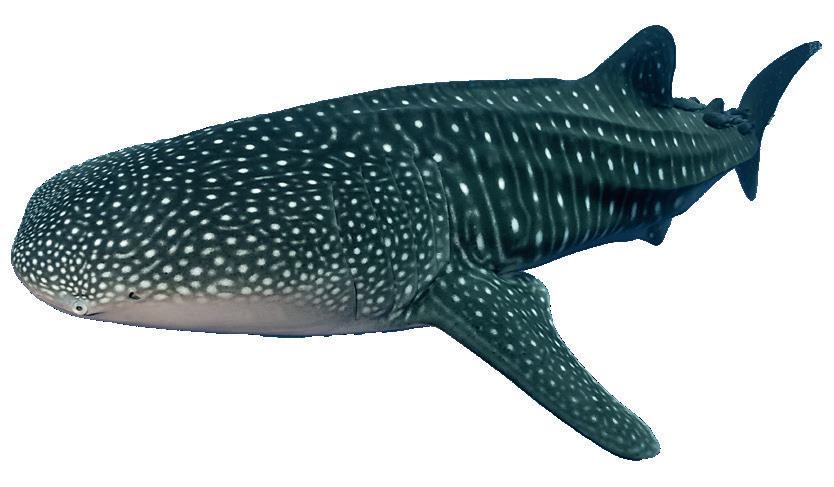
This crustacean might be small, but it packs a punch. It eats crabs – and other mantis shrimp – by smashing their shells with its naturally spring-loaded arms, delivering blows at up to 23 metres per second. That’s the equivalent force of a 22-calibre bullet. It will take on much bigger foes as well, earning it the nickname ‘thumb-splitter’ from divers who experienced the shrimp’s prodigious punches when they have tried to pick them up. Be warned. Mantis shrimp are a common sight in Kenyan dive sites such as Kisima Mungu and Kinondo Kwetu so you are sure to see them. They are also sure to see you as they have the best colour vision on our planet with eyes mounted on mobile stalks and are constantly moving about, independently of each other.
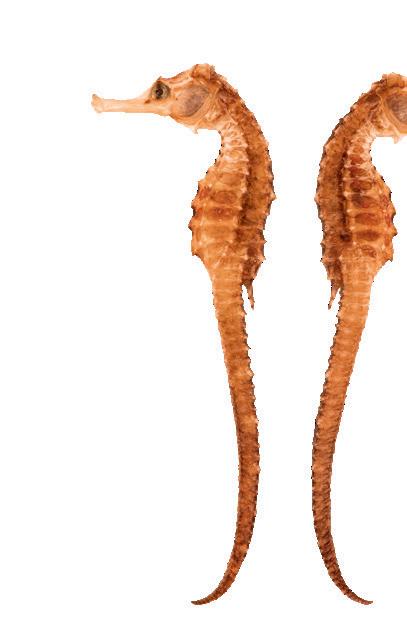

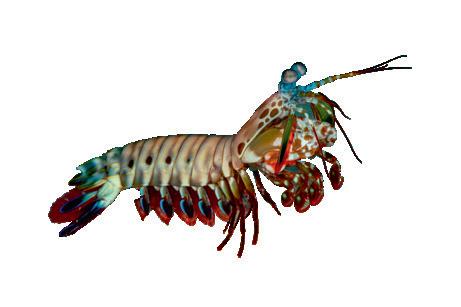

They can grow up to 12 metres long, weigh around 20,000 kg, have 300 teeth each and are sharks. You would think these facts would be enough to dissuade most from swimming alongside a group of whale sharks, but they are actually aquatic gentle giants and pose no harm to humans. The teeth are just for show and not needed to filter feed their daily diet of plankton. It’s this plankton – pushed out with the silt from the Rufiji River into the warm waters of the Indian Ocean – that draws them to Mafia Island from October to February – the longest whale shark season in the world. During this time, you are almost guaranteed to see them daily. Swimming with these shy creatures is a breath-taking experience, but you won’t be gasping for air trying to keep up with them. The top speed of a whale shark is about 5km an hour so human swimmers can comfortably swim alongside and take in the beauty of their mottled markings – individual to each fish – and their effortless grace through the water.
With a pedestrian-friendly centre, laidback lakeside living and a vibrant food scene, Kisumu City is a place you can take your time enjoying. The Link shares some highlights for visitors.

Kisumu is not Nairobi. In the nonstop Kenyan capital, the car – or perhaps matatu – is king and walking the city can be a risky venture. Kisumu, in comparison, is literally a breath of fresh air. The city is currently undergoing an urban rejuvenation of the downtown and lower town which includes modernising the lake front, decongesting main streets, and making the streets pedestrian friendly. With peak daily temperatures at around 30ºC all year round, Kisumu invites visitors to stroll the streets and soak up its calm charm.
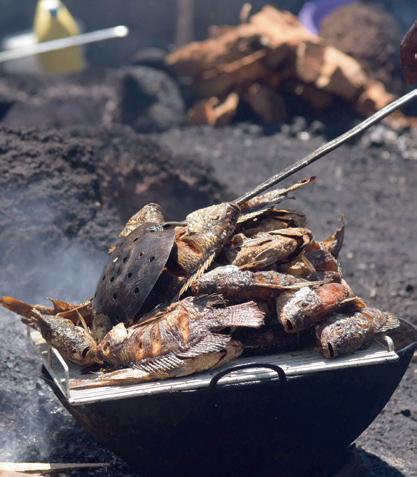
Among the treats revealed by wandering the city is Kisumu market. Locals know it as ‘Corona Market’ as during the Covid-19 outbreak, vendors were designated this large outdoor space to sell their wares. Kisumu is a region blessed with fertile land and the market showcases that agricultural bounty. Stroll the sprawling market and you’ll find mountains of mangoes, stacks of spices and loads of leafy vegetables. Vendors also sell the catch of the day from Lake Victoria fishermen, including the tiny sardine-like fish Kenyans call Dagaa that are sold by the scoop.
As well as dagaa, which local fishermen catch at night using lamps to attracts the tiny fish into their nets, the lake is a rich source of tilapia. This fish is often served fried accompanied by a plate of fresh vegetables and the dense corn meal of ugali. Another healthy local dish here is uji, or porridge. This ultimate comfort breakfast food is packed with gut-friendly probiotics created by leaving the dried maize or sorghum to ferment in water for a few days before cooking. This
process also gives the porridge it distinctive rich, sour flavour.
Only six per cent of Lake Victoria’s coastline belongs to Kenya so, as the country’s port city, Kisumu, has strategic importance. Its harbour facilitates regional trade within East Africa, connecting Kenya to the two countries that have a larger slice of the Lake Victoria pie, Uganda and Tanzania.
As well as commercial trade the coastline offers plenty of recreational options. Visitors can take a cruise or kayak on the waters or accompany locals on a fishing trip The centre of many of these lakeside is Dunga Beach. Here you can experience the scenic Dunga boardwalk, which is elevated above wetlands and surrounded by papyrus reeds. Dunga Beach village a popular landing site for fishing boats laden with the day’s catch and Dunga Hill Camp has a lovely lakeside bar to take in the special sunsets here with the sinking sun illuminates the lake in a ruby glow.
The peaceful Kisumu Impala Sanctuary is home to impalas, the
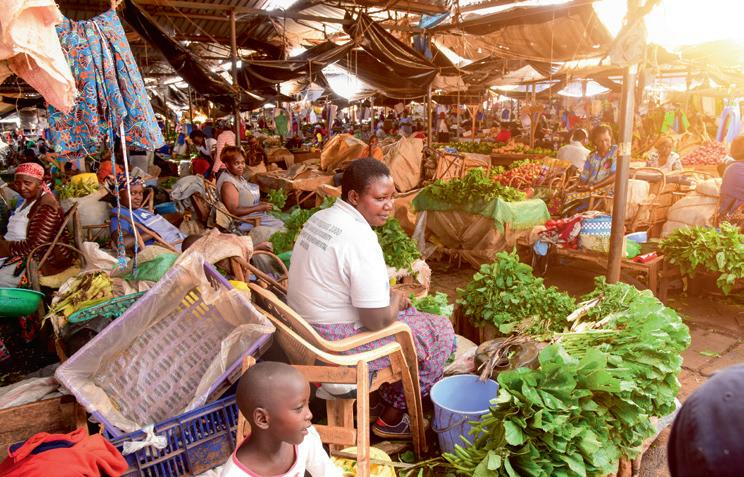


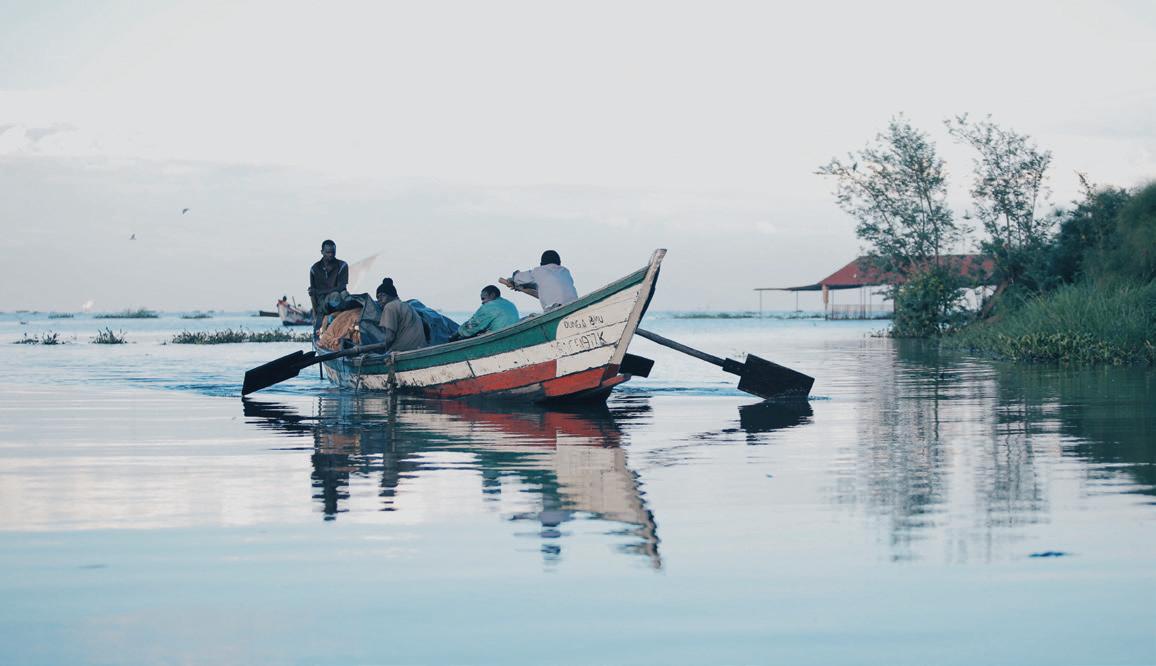
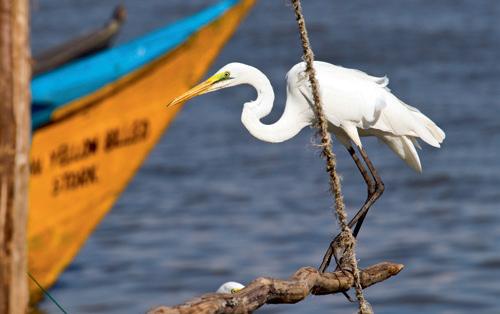
rare sitatunga antelope as well as big cats, buffalos, giraffes, cheetahs and several primate species. The sanctuary is also home to five campsites all with spectacular views of Lake Victoria. Bird watching, nature walks and glass-bottomed boat rides compliment the activities availed at the sanctuary.
To see more antelope in wilder terrain, head to Ruma National Park – a two-hour drive from Kisumu. This mosaic of landscapes, ranging from riverine woodland and rolling savannah to magnificent escarpments and towering cliffs, is Kenya’s last remaining sanctuary for the roan antelope. Birders will also
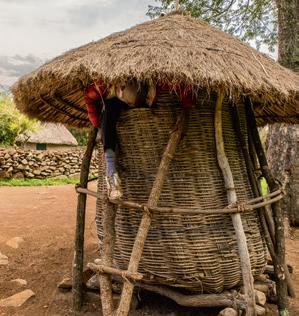

appreciate the chance to spot more rare species with the park the only protected area in Kenya where the vulnerable blue swallow, a scarce intra-African migrant, is regularly recorded feeding and roosting in the moist grasslands here.
Lake Victoria is a beautiful birding destination itself. Papyrus swamps along the shores are home to several birds not easily found anywhere else including papyrus gonolek, and African openbill.
A trip to Kisumu provides insight into the customs, culture and everyday life of the Luo, an ethnic
group native to western Kenya and the fourth most populous tribe in the country. Kisumu serves as the headquarters of the Luo-speaking people of East Africa. Luo descendents include former US President Barack Obama, whose father was born in the village of Kogelo about 60km northwest of Kisumu. A good place to start your cultural education is the Kisumu Museum. Here, among the artefacts you’ll find a Unesco-sponsored model of a Luo homestead along with examples of traditional clothing such as ostrich feather head-dresses.
It might also be useful to clue yourself up on some Luo taboos ahead of your time in Kisumu. For example, a Luo woman is forbidden to hit her husband with a cooking stick during a domestic argument. Should such a kitchen utensil assault take place, a special ritual is administered in which the couple has to drink a herbal concoction known as ‘manyasi’ which is considered the physical embodiment of forgiveness and restoration in Luo culture.
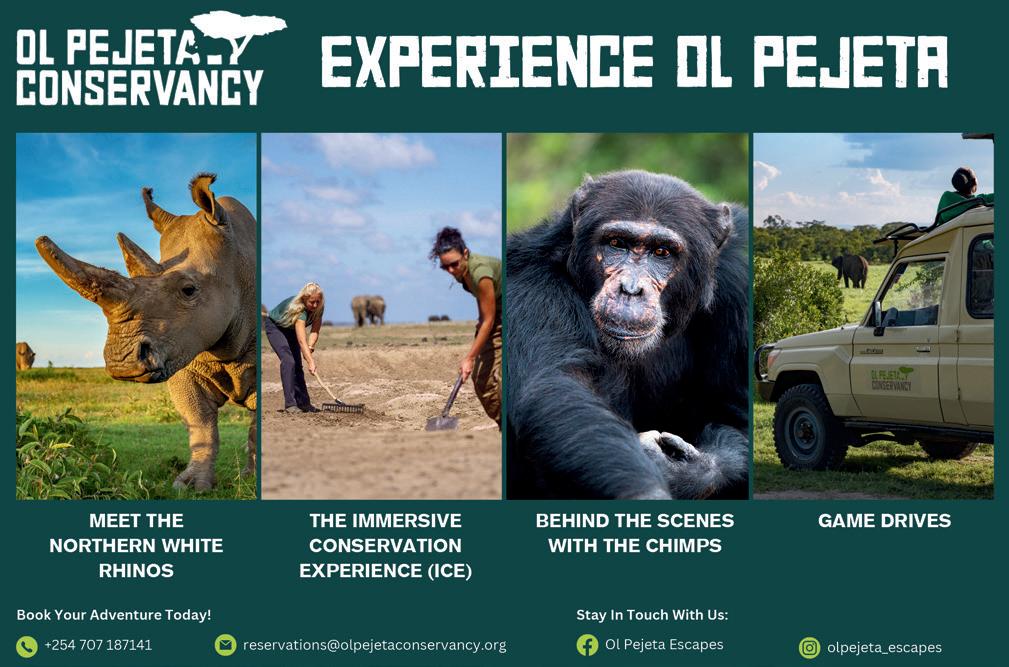
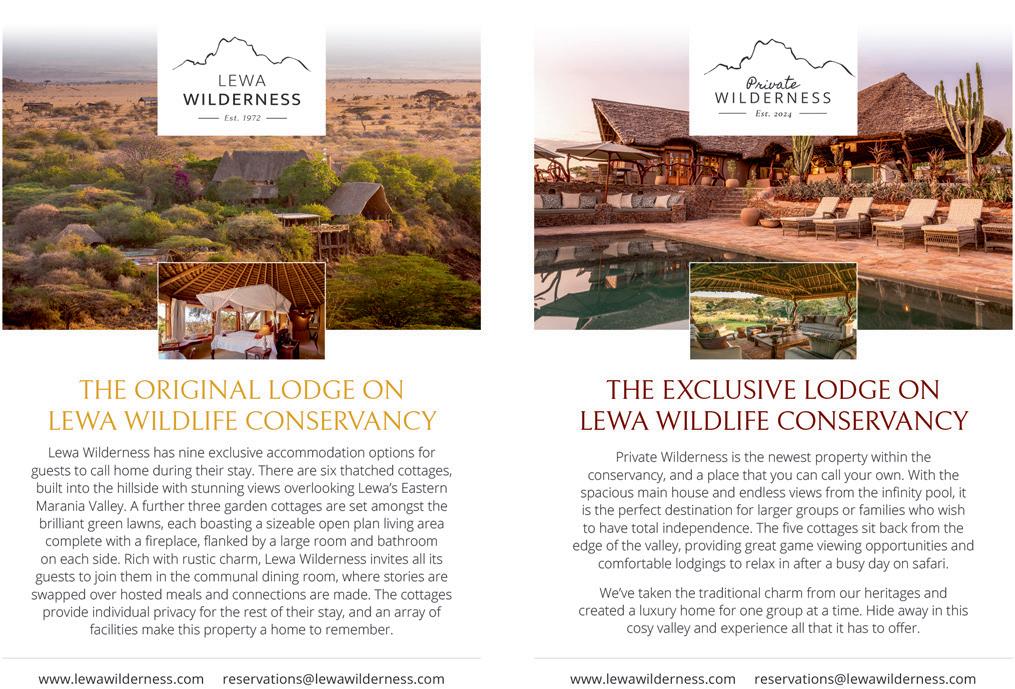
Cosmopolitan, with a fascinating history and an ideal beach-side base for nearby safari adventures, Mombasa is Kenya’s leading tourist destination.
Here are some essential experiences to soak up its Swahili vibe...

FLY WITH US: DAILY FLIGHTS TO MOMBASA
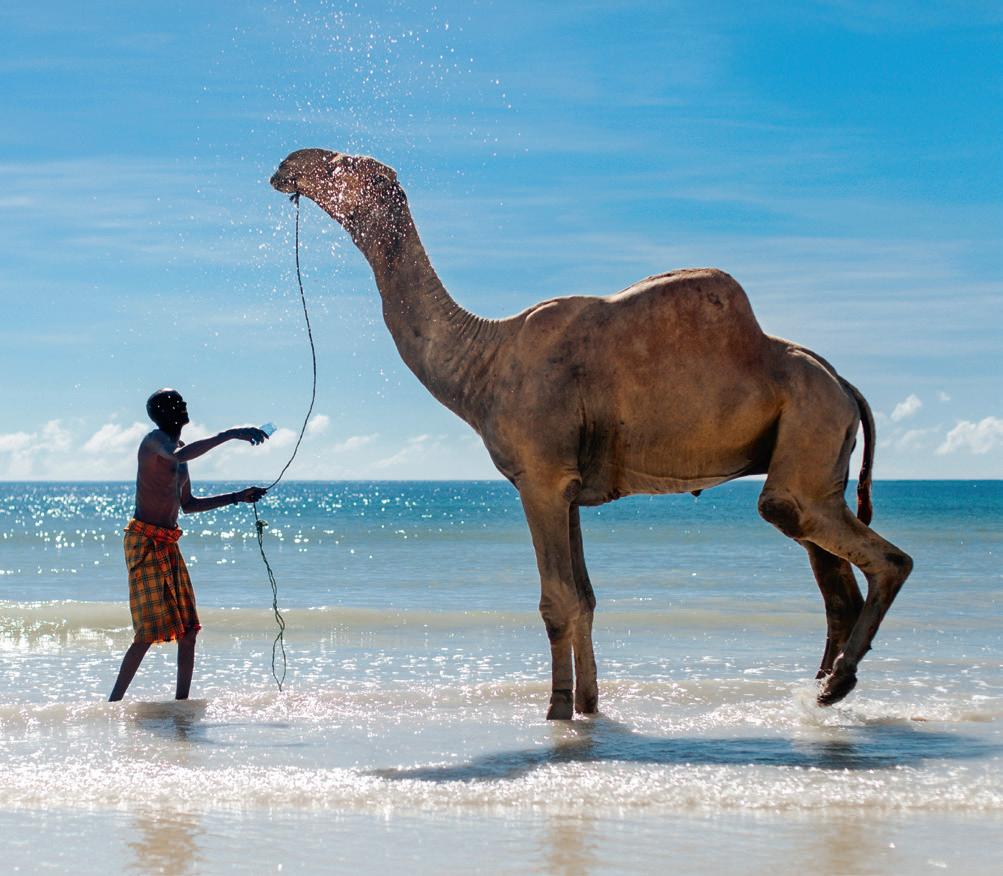
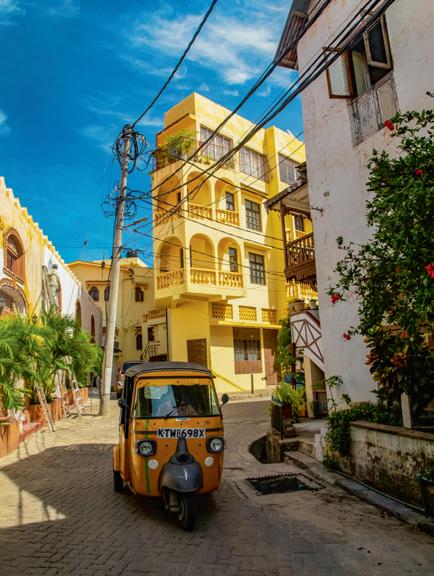
Mombasa is thought to date back to the 10th century, making it Kenya’s oldest city. Its coastal location has made it a strategic target for colonisers over the years. The many battles for control – with Oman, Portugal and Great Britain all having periods of rule – gave rise to its name with ‘Manbasa’ being derived from ‘Mvita’, the Swahili word for ‘war’. The Old Town, located on the island of Mombasa and separated from the rest of the city by Tudor Creek – is full of architectural reminders of this diverse cultural heritage such as such as the remarkably well-preserved 16th Portuguese military stronghold Fort Jesus and the Mombasa Old Town Mosque. The cosmopolitan community in this charming place is still a mix of African, Arab, British, Persian and Portuguese influence and walking the attractive narrow streets here is like immersing yourself in living history.
This stretch of the Kenyan coast boasts some of the best beaches in the world with vast swathes of pristine white sands, fringed by palm trees and lapped by sparkling blue waters. The headliner south of the city is Diani Beach, a 25km flawless strip of white sand which is a regular winner of the best beach destination in Africa and offers visitors a huge range of water sports and diving adventures. Another stunning sandy spot is Nyali beach, just a 10-minute drive north of Mombasa. Nyali is an affluent, leafy suburb filled with high-end beach-side resorts and attractions such as Africa’s largest crocodile farm and a network of coral caves supposed to bestow fertility on all who enter.
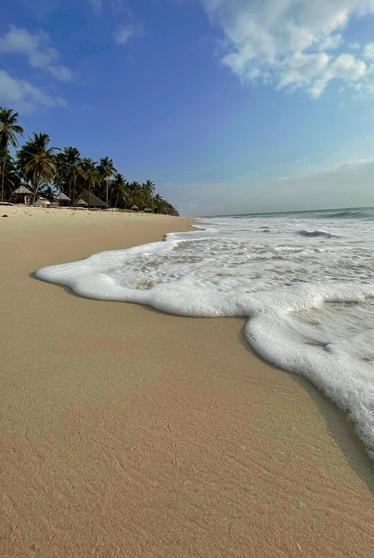
THE HEADLINER SOUTH OF THE CITY IS DIANI BEACH, A 25KM FLAWLESS STRIP OF WHITE SAND WHICH IS A REGULAR WINNER OF THE BEST BEACH DESTINATION IN AFRICA . . .

Get crafty and explore the work of local artisans

Exploring Mombasa will reveal plenty of skilled artisans in action. Head to Biashara Street for traditional kikois and kangas or visit Akamba village, just outside of the town, which has been producing generations of wood carvers for over a century. You’ll also find wood carvings, hand-printed textiles, jewellery, and leather crafts handmade by Mombasa residents with disabilities.


Since 1987 the waters of the coast here have been protected as the Mombasa Marine National Park and Reserve. With its spectacular coral reefs and diverse marine life shielded from human harm, the underwater area has become an exemplary snorkelling and scuba spot that is home to a variety of marine species including crabs, starfish, stone fish, sea cucumbers, sea urchins and turtles. Among the best dive sites are the purpose-sunk shipwrecks of the MV Dania and the MV Globe Star with groupers, glassfish, octopus, and lobsters making a home in the artificial reefs created by the submerged vessels.
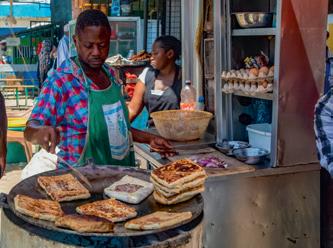
The melting pot of cultures in Mombasa have been the recipe for delicious dishes that are a blend of historical influences. A great way to sample some authentic delicacies is by exploring the vibrant street food scene. Roam the streets here of an afternoon or evening and you’ll notice the vendors frying, roasting and grilling on huge streetside jikos (stoves), which are raised and propped up by bricks or stones. Popular Swahili snacks include viazi karai – deep fried potato nuggets served piping hot with a spicy sauce – and the coconut or cardamon-flavoured doughnuts called mitai that are often accompanied by a cup of local spiced chai or the super strong Swahili black coffee kahawa.
You can drive to see the Big Five from Mombasa. There are several wildlife reserves within reach such as Tsavo East National Park, which has grassland habitats favoured by cheetahs and is also home to the Somali ostrich, gerenuk and the endangered Hunter’s hartebeest (hirola). The untamed Galana River and the animal-rich Kanderi Swamp are other excellent focus points for your stay. The Mombasa coast also has a number of truly amazing birding areas. A short drive north will bring you to the open savannah, woodland and wetlands of the Nguuni Nature Sanctuary, which attract many different species of bird. The Shimba Hills National Reserve is also rich in bird life with pelicans, flamingos, seabirds, doves, cuckoos, and weavers. There’s also the Mwaluganje Elephant Sanctuary – one of three coastal refuges.
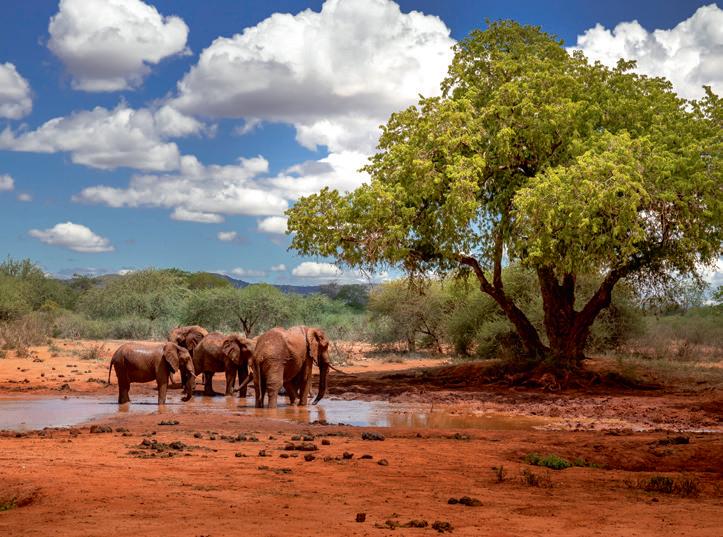
As an airline that flies to some of Kenya and Tanzania’s most unspoilt and beautiful locations, Safarilink is committed to projects that have a positive environmental impact. We take our corporate social responsibility (CSR) seriously and are involved in a wide number of projects that protect the people and places across our network.
Our CSR activities are focused on preserving nature and improving lives of communities in destinations that we serve. From Lamu to the Masai Mara and Laikipia‚ we support wildlife conservation‚ forest restoration‚ health and education projects. In addition, we are engaged in numerous acts of goodwill across the country to save nature and transform lives. To achieve this‚ we partner with reputable organisations operating in the destinations that we serve. Our efforts have won us many awards and collaborators.
It is a proven fact that poverty can be reduced, and the quality of life improved by raising the overall education level of a community. With this in mind, Safarilink has partnered with Naboisho Primary School (Masai Mara) and Elsa Primary School (Samburu).
Most pupils of both schools come from families with below-average financial resources and thus cannot even afford to provide the most basic school supplies. For every passenger flown to Naboisho and Samburu‚ we will contribute to each school a ‘pupil school kit’ consisting of a ruler‚
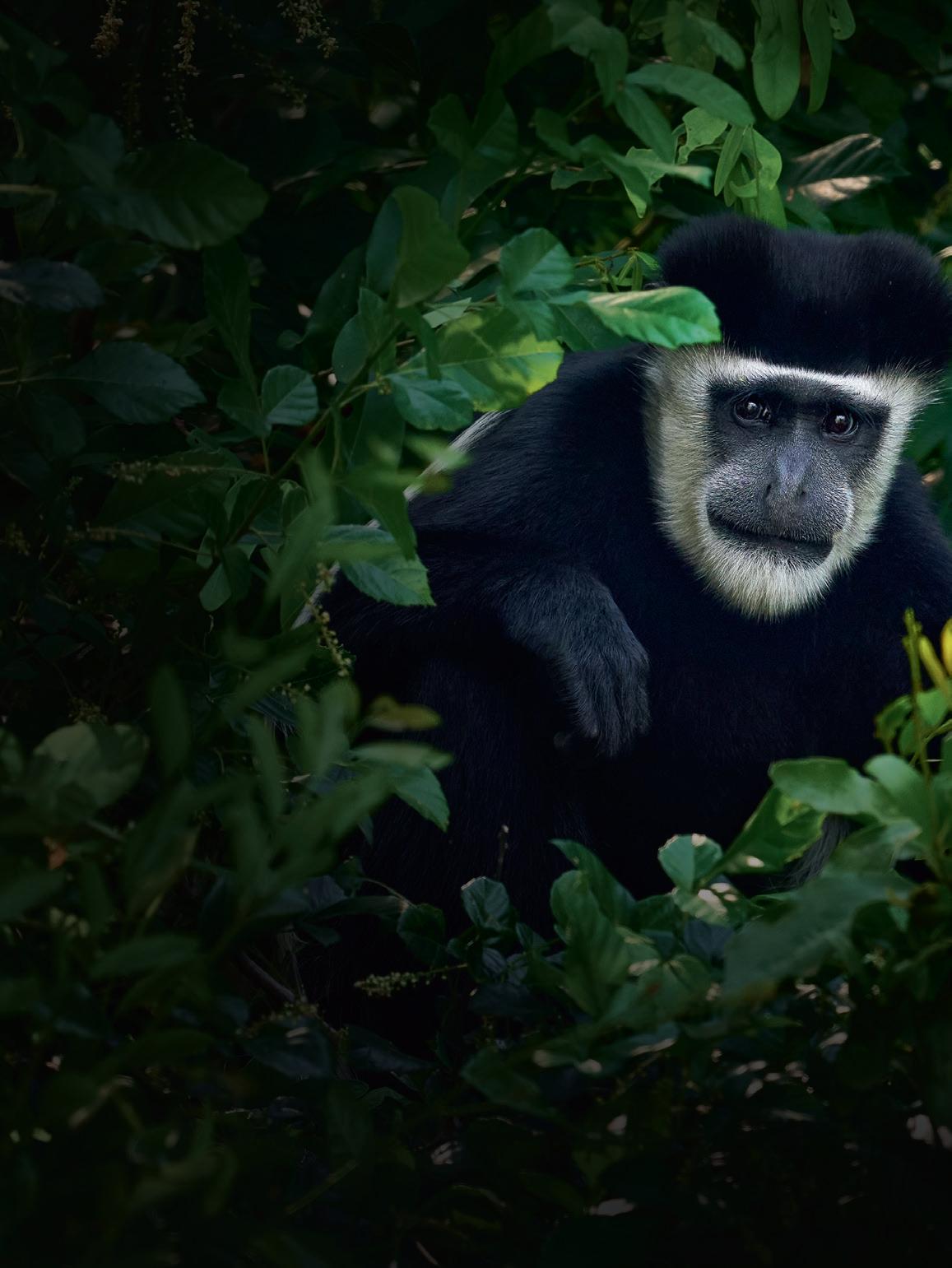
eraser‚ pens‚ pencils and exercise books. Additionally, we will provide each school with basic teaching aids such as chalk‚ solar-powered calculators‚ crayons and writing paper.
Our passengers are invited to help out by donating ‘pupil school kit’ items as above or suitable-age storybooks. There are collection boxes at Safarilink check-in counters.
The future of Kenya’s lions and other wildlife lies in the hands of the country’s youth. Yet‚ despite living in close proximity to world famous National Parks and Reserves‚ many Kenyan children have not had the opportunity to observe wildlife at close range. That’s why Ewaso Lions created the Lion Kids Camp programme: to inspire local children to become the next generation of park wardens‚ safari guides‚ and wildlife conservationists. Safarilink has been a supporter of the camp since 2016 when it financed the printing of 400 copies of Simba Stories‚ a collection of lion stories‚ poems and illustrations made by students from Lpus Leluai Primary School in Samburu. All children who attended that year’s Lion Kids Camp received a personal copy of Simba Stories.

The community-built Aitong Health Centre on the North-East border of Mara North Conservancy provides much-needed medical supplies and holds free annual medical camps open to the Maasai population in the area. Safarilink has been a proud partner to the camp since 2017 and provides air tickets to its team of doctors as well as discounted rates to staff at Land & Life Foundation that supports the heath centre.
A decade ago, Safarilink signalled its support of the Kenya-based wildlife charity Wildlife Direct’s flagship campaign Hands Off Our Elephants by branding all aircraft with the slogan ‘Hands off our elephants’. We became the first
airline to partner with Wildlife Direct to help raise public awareness to stem the trafficking of ivory and other wildlife products.
This campaign is important because Kenya is renowned as a hub for the transiting of ivory and 80 percent of the ivory exiting Africa is passing through Uganda‚ Kenya and Tanzania. We hope our clear message will deter travellers from carrying ivory or other wildlife products by informing them about the impact of the wildlife trade‚ and risk of arrest and penalties for possession of these products.
As part of our efforts to protect Kenya’s unique wildlife heritage, Safarilink donates five per cent of the price of every ticket for flights to Lewa to the Lewa Wildlife Conservancy. The award-winning sanctuary is a safe haven for the critically endangered black rhino and several others of Kenya’s threatened wildlife species. Our support goes towards a wide

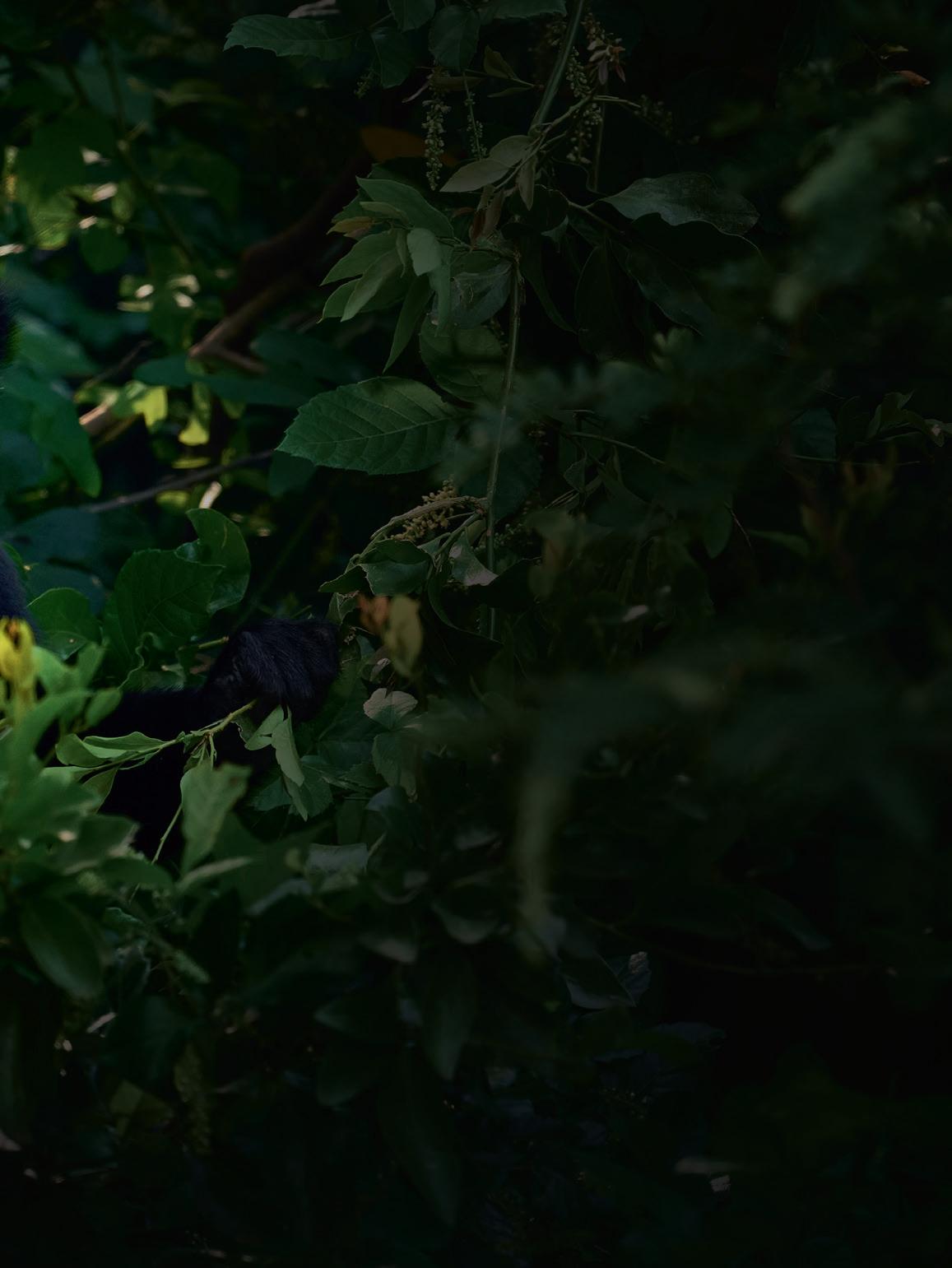
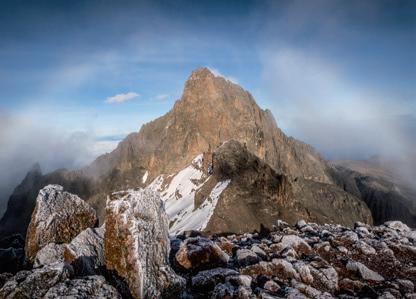

range of conservation activities including security‚ research‚ translocation and land management.
Mount Kenya Trust is committed to long-term conservation of biodiversity of Mount Kenya National Park. In partnering with the trust in its native tree-planting programme we became the first local airline to be carbon neutral. We have scaled up our funding in recent times with thousands of seedlings now provided each year.

As part of our efforts to protect Kenya’s unique wildlife heritage, Safarilink donates five per cent of the price of every ticket for flights to Lewa to the Lewa Wildlife Conservancy.

This UK charity was set up in 1995 to provide medical and education aid to vulnerable communities in remote parts of Kenya’s north coast. For 30 years‚ the charity has performed life-changing and life-saving operations to thousands in need. In support of their
work‚ we donate tickets each year to transport doctors involved in the medical camps. Each camp is a life transforming opportunity for select medical cases.
This not-for-profit organisation focuses on protection‚ conservation‚ and preservation of primates‚ especially the nationally threatened colobus monkeys of which only a few thousand remain in Kenya. Located in Diani on Kenya’s South Coast‚ the conservation’s projects include the famous “colobridges’, a series of rope ladders spanning the resort’s Beach Road to reduce injury and death of monkeys hit by vehicles. Safarilink is a long-term sponsor of Colobus Conservation. For each passenger we fly in or out of Diani airstrip‚ we donate towards their conservation efforts.
The camp is organised during the annual Maulidi Festival on the island. The camp attracts thousands of people and hundreds of specialised surgeries are undertaken. Each year we donate tickets to doctors who conduct these life-transforming surgeries.
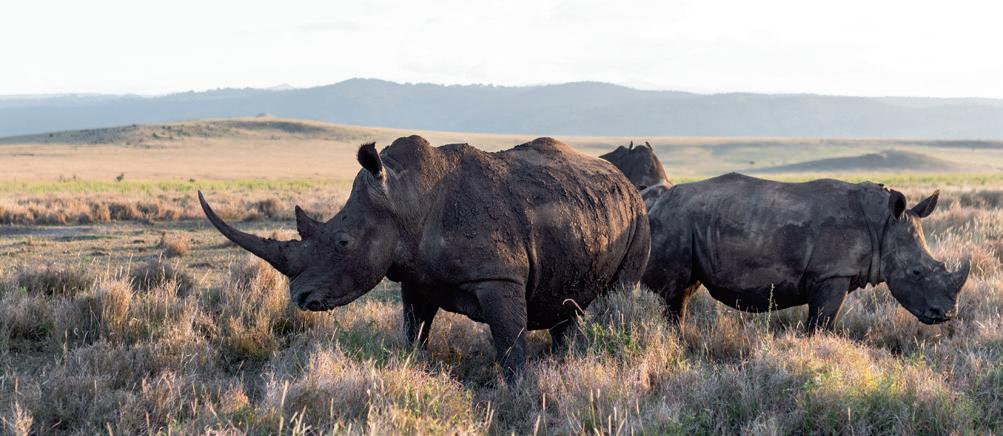

AVERAGE LENGTH 62 KM
ESTIMATED DIFFICULTY HIGH
AVERAGE DURATION 5 TO 7 DAYS
ACCOMMODATION CAMPING
When booking your bucket-list hike up Mount Kilimanjaro it is important to bear in mind there are seven possible routes to the top. To help you make an informed choice on which one you should follow, experienced guide JOSEPHAT MASHEHE breaks down the pros and cons of each.
Almost half of people who take on Mount Kilimanjaro do so via the The Machame route – also known as the ‘Whiskey’ route. The scenery is excellent with four types of landscapes to pass through. This is a good route for dealing with altitude as many tours allow you to climb high and go back down to sleep low on the same days, allowing your body to better adjust to the elevation. Extra rest days are often available and if you have the time or money for this, it’s worth the investment to lower the risk of altitude sickness and also physically prepare yourself for the summit climb.
The route can get crowded. Like all the camping routes on Kilimanjaro, porters will carry the tents. Walking days are longer on Machame than the other popular route, Marangu, and steeper, so it’s considered more challenging. This trail for Machame starts in the south before heading east under the southern ice field before
the summit bid. You then descend on the Mweka route, which is used as a downhill-only path for many of the routes from the summit. There are two particularly difficult sections on this trek – an area before the Shira ridge, and the Barranco Wall – both of these are physically challenging and also may affect those with a fear of heights. Overall, though, this is a highly rated route with an excellent success rate and has some of the best scenery of all the routes. Just be prepared for it to be busy!
AVERAGE LENGTH 72 KM
ESTIMATED DIFFICULTY MEDIUM
AVERAGE DURATION 5 TO 6 DAYS
ACCOMMODATION HUT/DORMS
The oldest and the second most popular trail is the Marangu Route, or the ‘Coca-Cola’ route – so called because porters used to bring bottles of the soft drink to the various huts along the trail. Around 40 per cent of all visitors take this trail so it is one of the busiest. It is the preferred route for more casual and inexperienced trekkers as it is considered the easiest of the Mount Kili-

manjaro hiking options. However, this also contributes to it having the lowest success rates – which is usually attributed to people underestimating its difficulty and the route’s extreme altitude changes. Many tours offer an extra day to do this route to combat the risk of altitude sickness and it’s definitely worth investing in that to maximise your chances of resisting the effects of altitude.
The other reason this route is so popular is that the Marangu route is the only one to offer hut accommodation along Kilimanjaro for its entire length. Trekkers sleep in dorms with mattresses and other basic amenities, although there is no electricity. Usually, you can buy snacks and drinks at the huts as well. The Marangu route departs from the south-east of Kilimanjaro and reaches Uhuru Peak (the summit) via Gilman’s Point. It is also the only route to use the same trail on the descent, so in terms of scenery variation over time it’s probably the weakest option, however, the views that you do get are great, especially from the Saddle. This is a good route if you’re short on time or do not want to camp.
AVERAGE LENGTH 73 KM
ESTIMATED DIFFICULTY MEDIUM
AVERAGE DURATION 6 TO 7 DAYS
ACCOMMODATION CAMPING


FLY
Popular with more expensive tours and much quieter than the main routes, the Rongai route travels along a more isolated part of the mountain and starts off much more easily
than the other treks. Accommodation is camping only, except for the last night which usually finishes in a hut. Rongai is unique in that it’s the only trail which approaches Kilimanjaro from the north, which as well as giving you a different perspective on the mountain, also allows for clearer views of the peak. The highlight aside from the summit are the first few days in which you’ll pass through unspoiled wilderness and alpine desert near the Kenyan border, with plenty of wildlife spotting opportunities, although after that, the scenery is less varied than other routes. Many trekkers coming in from Kenya prefer this route.
This is one of the easier trekking options for Mount Kilimanjaro with flatter gradients than the other routes, however, there’s less opportunity for acclimatisation and the northern approach summit day is one of the toughest. A good option for less-experienced trekkers who want to get away from the busy Marangu route, and for those who want a slightly more sedate and chilled version of the trek!
AVERAGE LENGTH 70 KM
ESTIMATED DIFFICULTY HIGH
AVERAGE DURATION 6 TO 8 DAYS
ACCOMMODATION CAMPING
The Lemosho route is an exceedingly scenic route that starts to the west of Mount Kilimanjaro before joining the Southern Circuit, and then varies depending on the tour, with some joining the Machame route and others going onto the Northern Circuit. Typically, it descends via the Mweka trail. It is another very quiet trail and has camping only, making it a great way to get away from the crowds, however, it is one of the tougher routes of Kilimanjaro. The rewards are excellent though, with amazing scenery, including a nice heath section. Lemosho is also one of the best routes for acclimatisation with high summit success rates.
Like the Rongai route, the start is in a scenic, remote area giving the opportunity to see wildlife and it also offers great views of the dramatic gorges which lie on Kilimanjaro’s western side. Another bonus is the chance to hike over the Shira Plateau, one of the highest in the world. It’s also a peaceful route which only gets busier when it joins the more popular trails. Bear in mind that Lemosho is not usually recommended during the rainy season as the start point can become inaccessible.
AVERAGE LENGTH 70 KM
ESTIMATED DIFFICULTY HIGH
AVERAGE DURATION 6 TO 8 DAYS
ACCOMMODATION CAMPING
The Shira route is actually the original version of the Lemosho route. It starts at a much higher altitude with travellers transported to 3,600 metres at Shira Gate and on day two merging with the Lemosho route. For this reason, it’s usually only offered to trekkers who have already acclimatised to high altitudes and can be dangerous to those who haven’t. The advantages are that it’s a day quicker than the Lemosho route, and the drive up is spectacular.

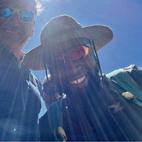
Choosing the right guide can make all the difference in ensuring a safe, successful, and unforgettable climb. Josephat has over 15 years of experience climbing and guiding Mount Kilimanjaro and has successfully led over 500 climbers to the summit. He is certified by the Kilimanjaro National Park Authority (KINAPA) as an official guide. Josephat speaks
When is the best time to climb Mount Kilimanjaro?
• January and February are great times to climb Kilimanjaro. The weather is relatively warm, and visibility is good. However, it is a busy time on the mountain.
• March to May is the long rainy season. There are very few people on the mountain, but the trail conditions can be very muddy, wet and snowy.
• June is a transitional period that is characterised by low visibility and cold temperatures. It is considered the start of the climbing season.
• July to October is the busiest period on the mountain. It is dry but the temperatures are relatively cold. Visibility is great.
• November is the short rainy season. Precipitation is moderate compared to the long rainy season. Few visitors climb Kilimanjaro during the month.
• December is a crowded time due to the holiday season. But the short rainy season often runs into this month.
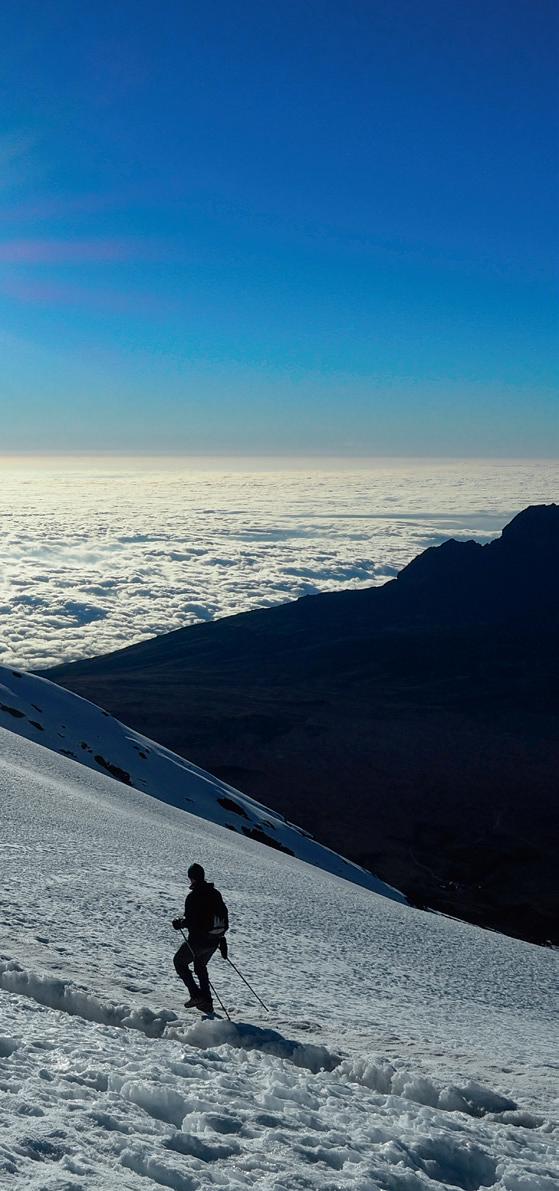
English fluently in addition to Swahili and other local languages. He also provides thoroughly checked equipment for climbers who need it and meticulously checks their condition daily to maximize safety. Josephat is among the guides at Mount Kilimanjaro Guide. Find out more at mountkilimanjaro.guide or email mountkilimanjaro@gmail.com
For more details on Josephat, head to his Instagram account @josephatmashehe
AVERAGE LENGTH 98 KM
ESTIMATED DIFFICULTY HIGH
The newest route on Mount Kilimanjaro is another very quiet trail and the longest hike available. It has very high success rates as the length of the trip gives lots of opportunity for acclimatisation. This trek starts on the Lemosho route but after a few days strikes out on its own, traversing the deserted northern slopes of Kilimanjaro with spectacular scenery – and offering views that you won’t get on the other routes.
AVERAGE DURATION 9TO 10 DAYS
ACCOMMODATION CAMPING
Thanks to its length the Northern Circuit has very varied scenery and goes nearly all the way around Kilimanjaro. So, this is one of the best, however, it’s also generally the most expensive tour as it’s so long. You’ll also need to be prepared for the endurance required for the extra days hiking and camping.
AVERAGE LENGTH
Probably having the least foot traffic of all the routes, the Umbwe route is perfect for those wanting to get away from it all. This is a fast and direct route for experienced trekkers, being the hardest of the main trails with the steepest climbs. Its sharp altitude changes are reflected by its lower success rates. You should only consider the Umbwe route if you are confident at high altitudes or have pre-acclimatised. In return, you’ll get the quietest trip of all, with stunning ridges and some of the best views of any route. This route starts to the southwest of Kilimanjaro and climbs steeply, before usually connecting to the Southern Circuit before summitting. Umbwe is also well known for its many caves which can be visited during the trek.
53 KM
ESTIMATED DIFFICULTY VERY HIGH
AVERAGE DURATION 5 TO 7 DAYS
ACCOMMODATION CAMPING
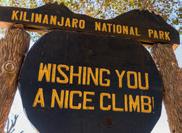
Although it’s no longer a main Kilimanjaro route, it would be remiss not to mention the Western Breach. This is a dangerous route and is not offered by most tour operators for this reason. In 2006 the route was temporarily closed when a rockfall killed three unfortunate trekkers. This is a steep route with poor acclimatisation and despite changes to the trail and route since re-opening, it still has hazards which make it too unsafe for most. This is a route for very experienced trekkers and climbers and technically difficult.
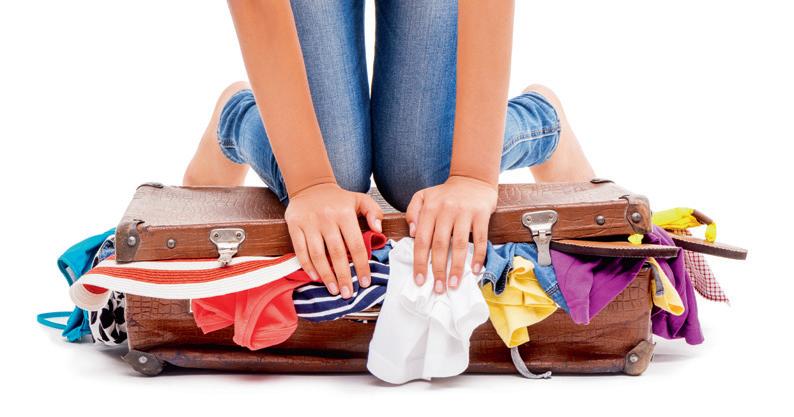
Fail to plan, plan to fail. To ensure you don’t miss any essential items (plug adaptors, charging cables, medicines or must-have toiletries) get it down in writing first.
Rolling is the new folding. Generally, it's better to roll clothes because it takes up less space and allows you to pack more while reducing wrinkles.
Just stuffing your phone and laptop chargers in your case will take up room and could result in essential equipment getting damaged. Wrap them up properly or invest in a multi-way cable for an all-in-one solution.
In addition to keeping dirty laundry away from your clean clothes, a pillowcase means no need for disposable plastic bags or purchasing a separate laundry bag.
2
4 8 3 5 6 7 1
Stick heavy and bulky items like shoes and toiletry bottles at the bottom of your suitcase. This way, when you’re wheeling your case around, they won’t squash and crease your clothes.
Taking multiple pairs of shoes? Cancel out the space they take up by stuffing them with socks. It also protects the shape of your shoes during travel. Win-win!
Opening a case to find a bottle of face cream is now moisturising one of your best blouses after the top popped mid-flight is a holiday horror. Travel-size toiletries minimise the risk or you could pack any liquids in their own plastic bag.
Make sure you leave enough space in your suitcase when you’re getting ready to depart. You can also help by choosing souvenirs that don't take up much space like jewellery or postcards. Secure your souvenirs by surrounding them with clothing.
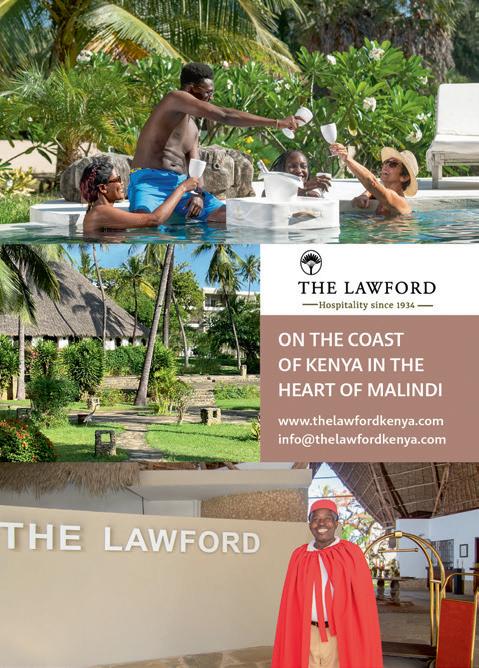

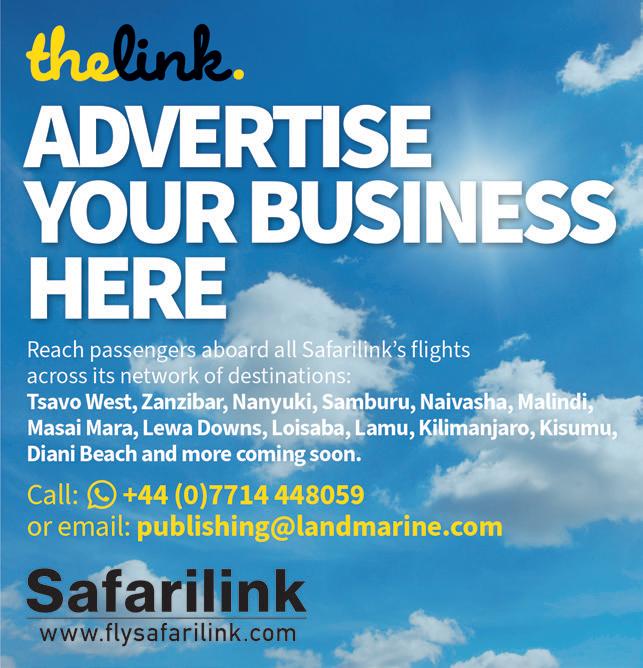
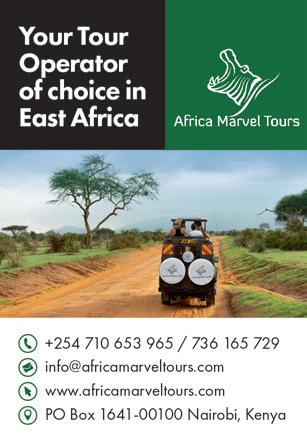
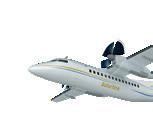
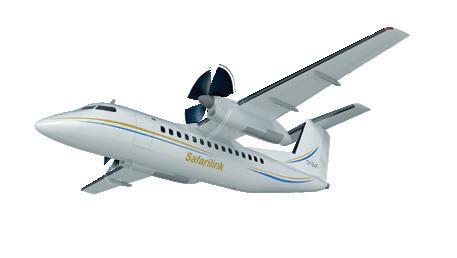

From Kenya’s premier national parks through Africa’s highest mountain to the best beach resorts of the Indian Ocean coast, Safarilink’s network of 17 destinations showcases East Africa’s finest attractions.
The non-stop Kenyan capital is also Safarilink’s hub with our operations centred at the city’s Wilson Airport. Nairobi is the place to soak up Kenya’s contemporary culture with its vibrant food, music and art scenes. If you want to escape the bustle, head to the capital’s ‘green lungs’, Karura Forest, or make the most of Nairobi being the world’s only wildlife capital with a visit to Nairobi National Park.
WEST (Daily flights)
Tsavo West National Park offers some of the most magnificent game viewing in the world with its safari staples including elephant, rhino, hippos, lions, cheetah, leopards and buffalos.
NANYUKI (Three flights daily)
The gateway to the wilderness of Mount Kenya National Park where wildlife includes leopards, giant forest hogs and more than 100 bird species. The town is also the starting point to trails ascending Africa’s second-highest peak, Mount Kenya.
MOMBASA (Daily flights)
Kenya’s historic second city is a living museum that reflects its time as a trading hub linking Africa with China and India. It is also an excellent starting point for Kenya’s renowned beach resorts.
MALINDI (Daily flights)
The town of Malindi sits amid a string of tropical beaches
dotted with hotels and resorts. Much of the spectacular coastline is protected by the Malindi Marine National Park and there is more untouched natural splendour at the nearby Arabuko-Sokoke Forest Reserve, which is home to elephants and more than 200 species of birds.
(Three flights daily)
The Lewa Wildlife Conservancy is famous for the variety of rare wildlife it protects. Set in a valley in the middle of the Laikipia Plateau, it is home to East Africa’s largest rhino population as well Grevy's zebra, Sitatunga antelope, cheetah, lion, elephant and reticulated giraffe.

LAMU (Daily flights)
Sun, sea and Swahili culture. Lamu is a true island escape. Wander the labyrinthine streets of its Unesco-recognised town – the oldest and best-preserved Swahili settlement in East Africa – take in the spectacular sunset from a traditional dhow fishing boat or just explore the stretches of footprint-free beaches that ring the island.
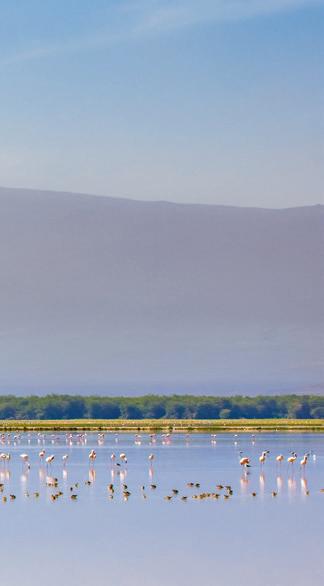

(Daily flights)
Africa's highest peak, Mount Kilimanjaro, is on the bucket-list of every climber. There are a variety of guided routes to the snow-capped summit to suit all levels. Once you’ve completed your climb extend your stay with a safari in Kilimanjaro National Park, a tour of the coffee plantations in the foothills or hit the town of Moshi for an urban adventure.
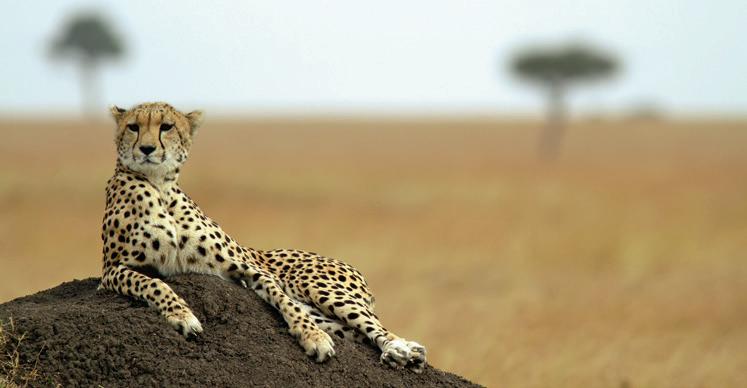
(Daily flights)
Mount Kilimanjaro provides the stunning backdrop to the Amboseli National Park, framing your safari views of huge herds of elephant as well as leopard, lion, cheetah, giraffe and more than 600 bird species.
ZANZIBAR (Daily flights)
This vibrant Indian Ocean island offers visitors a taste of Swahili culture old and new. In the ancient port of Stone Town coral and limestone houses, palaces, and forts survive from its 19th century trading heyday while the island’s coastline is a blend of sleepy fishing villages and swanky beach resorts. Inland follow your nose for the heady perfume of the spice farms.
(Three flights daily)
The Samburu National Reserve is known for its abundance of rare northern specialist species such as the Grevy Zebra, Somali Ostrich, Reticulated Giraffe, Gerenuk and the Beisa Oryx – also referred to as the ‘Samburu Special’.
(Three flights daily)
The calm, glassy waters of Lake Naivasha contain a huge
hippo population. Boat trips are available, some that take you to the privately owned game sanctuary of Crescent Island, which is walkable and will reveal giraffe and zebra. Far more wild animals are to be found in the neighbouring Hell’s Gate National Park with herds of buffalo and all manner of antelope roaming amid the dramatic Rift Valley landscape.
(Four flights daily)
The wild and rugged landscapes of the Masai Mara offer Kenya’s premier safari adventures. From July to October, it hosts the world-famous Great Migration of 1.5 million wildebeests with the Mara river crossings a dramatic highlight. The park also hosts all of the Big Five animals.
(Three flights daily)
The Loisaba Conservancy in Northern Kenya is a haven for over 260 bird and 50 mammal species, including endangered Grevy’s zebra. Big cat lovers will also find prides of lions, cheetahs and leopards. African wild dogs, thought for many years to be extinct in the region, are returning.
(Two flights daily)
Kenya’s third-largest city is situated on the northern shores of Lake Victoria. The lakeside vantage point offers some spectacular sundowner opportunities as well as boat rides and fishing trips. For animal adventures, head to the Kisumu Impala Sanctuary that shelters herds of impalas, zebras, cheetahs and baboons.
(Two flights daily)
The Kenyan coast is blessed with beautiful beaches galore, but Diani may be the fairest of them all. With 15 km of powdery white sand and waters calmed by an off-shore coral reef it provides ideal conditions for swimming, snorkelling, scuba diving, kite surfing, and water sports like windsurfing and kiteboarding.
(Daily flights)
The high altitude and clean air of this city nestled in the highlands of western Kenya has produced some of the world’s best distance athletes. It is a place that rewards the outdoor life with natural attractions such as the Rift Valley, Kakamega Forest, Kerio Valley and the Nandi Hills nearby.

Kisumu
Samburu Loisaba Nanyuki Naivasha
Lewa Downs
Migori
Masai Mara
Kilimanjaro Amboseli
Tsavo West
Zanzibar
Malindi Lamu
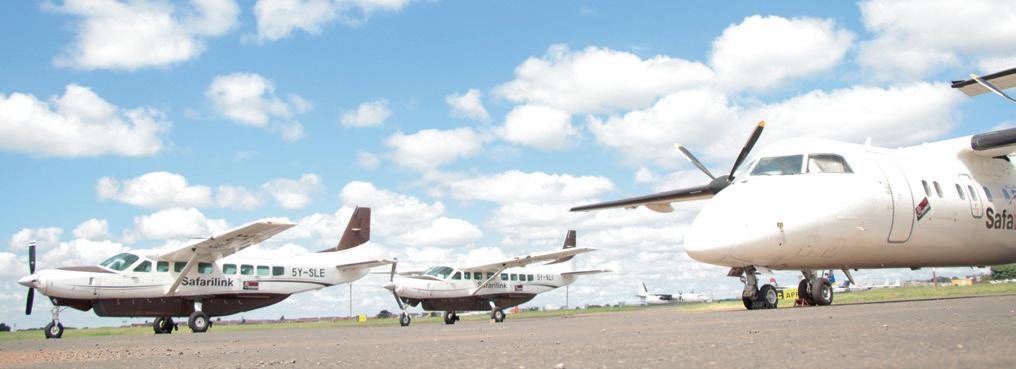
The 14-strong Safarilink fleet includes aircraft suited to the remote airstrips and short flight times that make up the majority of the destinations we serve. We also have four twin-engine Dash 8s to fly more passengers on longer routes
CESSNA CARAVAN C208BS
Number of aircraft: 10
Engine type: Turbo-prop single engine
Manufacturer: Textron Inc (formerly Cessna)
Crew: Two pilots
Maximum passengers: 12
▪ This workhorse of the fleet is a rugged fixed under-carriage aircraft that is ideal for landing on the ‘dirt’ airstrips common in game parks. Its high wings and large windows allow exceptional viewing of the unfolding scenery and animals while in flight. Our Cessna Caravan fleet now totals 10 after the arrival of two new aircraft in March 2024.
8-106 (5Y-SLD)
Number of aircraft: One Manufacturer:
DeHavilland Canada
Engine type: Twin engine Crew: Two pilots and one flight attendant
Maximum passengers: 37
▪ This Pratt & Whitney 120A powered aircraft is well known to commuter travellers around the world. Its pressurised cabin enables it to fly above the weather on the longer routes and its all-leather seats provide a touch of luxury.
ADDRESS: PHOENIX HOUSE, WILSON AIRPORT, PO BOX 5616, NAIROBI 00506, KENYA
TEL: +254 20 6690000/ +254 730 888 000
EMAIL: RES@FLYSAFARILINK.COM
WEBSITE: WWW.FLYSAFARILINK.COM
CALL CENTRE: 020 669 0000
NAIROBI
PHOENIX HOUSE, WILSON AIRPORT MOBILE: +254 730 888 000
8-315 (5Y-SLK)
Number of aircraft: One Manufacturer:
DeHavilland Canada
Engine type: Twin engine Crew: Two pilots and two flight attendants Maximum passengers: 52
▪ This Pratt & Whitney PW123E powered aircraft has a pressurised cabin which enables it to fly above the weather on the longer routes. It features all-leather seats for each passenger.
8-311 (5Y-SLC)
Number of aircraft: One Manufacturer: DeHavilland Canada Engine type: Twin engine Crew: Two pilots and two flight attendants Maximum passengers: 50
▪ This Pratt & Whitney PW123B powered aircraft has a pressurised cabin which enables it to fly above the weather on the longer routes. It features all-leather seats for each passenger.

DIANI
TELEPHONE: +254 710 772 222/ 735 697 410
EMAIL: DIANIOFFICE@FLYSAFARILINK.COM
KISUMU
TELEPHONE: +254 793 500 500/ 757 500 500
EMAIL: KISUMUOFFICE@FLYSAFARILINK.COM
MALINDI
TELEPHONE: +254 769 700 700
EMAIL: MALINDIOFFICE@FLYSAFARILINK.COM
LAMU
8-202 (5Y-SLO)
Number of aircraft: One Manufacturer: DeHavilland Canada Engine type: Twin engine Crew: Two pilots and one flight attendant Maximum passengers: 37
▪ This Pratt & Whitney PW123D powered aircraft has a pressurised cabin which enables it to fly above the weather on the longer routes. The interior is with all leather seats to provide a touch of luxury.
TELEPHONE: +254 769 600 600
EMAIL: LAMUOFFICE@FLYSAFARILINK.COM
MOMBASA
TELEPHONE: +254 769 000 444/ 101 888 000
EMAIL: MBAAIRPORT@FLYSAFARILINK.COM
ZANZIBAR
TELEPHONE: +255 674 308 858
EMAIL: ZNZOFFICE@FLYSAFARILINK.COM
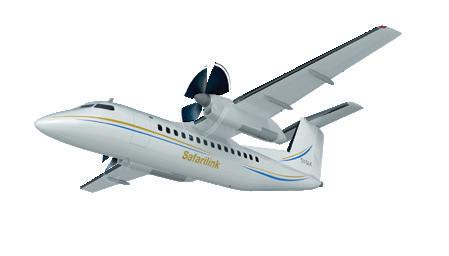
Pay for your flights on our www. flysafarilink.com by credit card or mobile money when making your booking. Alternatively, email res@flysafarilink.com for other payment options such as credit card payment links‚ or bank transfer options.
Children of two years of age and above but not more than 12 years of age are charged at 75 per cent of the applicable adult fare‚ depending on the class booked. Infants under two years of age are not charged providing they are not occupying a seat. Infants are not entitled to a baggage allowance.
Save time at the airport and check-in online between 18 hours and two hours before your flight. You can also checkin and download your boarding pass on your phone. When you check-in online‚ you can choose your seat for free. Once you have checked in online you will be required to present yourself at the check-in counter to confirm your presence.
Check-in counters will close 45 minutes prior to departure time on international flights (to/from Zanzibar and Kilimanjaro) and 30 minutes prior to departure time on other services. After these cut-off times passengers will not be allowed to check-in.
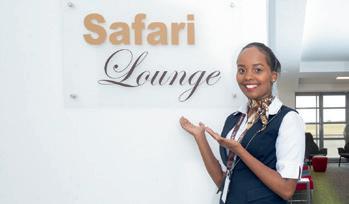
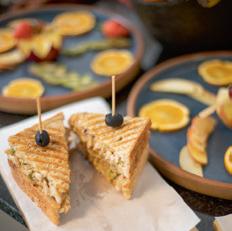
Our Safari Lounge is an extension of our main dedicated lounge and is located at our head office on the first floor at Wilson Airport‚ Nairobi. Whether you’re travelling for business or pleasure‚ you can relax in our executive lounge for up to four hours before your flight. While here passengers can enjoy the services of a personalised barista with coffee roasted by hand. They can also take advantage of the shower facilities and

the drink and snack bar. The Safari Lounge opens daily from 0600hrs to 1600hrs and can be booked for passengers on both private charters or scheduled flights at a fee of US $40 per person. It must be booked at a minimum of six hours prior to departure time. Children under 12 years will not be permitted unless booked as part of a private charter group. To book‚ contact our reservations team at res@flysafarilink. com or call +254 730 888 000.
▪ Safarilink’s frequent flyer programme, ‘Safari Bonus’, allows passengers to earn reward points on every Safarilink scheduled flight. To sign up complete the online enrolment form on our website.
▪ Once you have signed up you will get a membership number, which you will need to quote at the time of booking or upon checking in.
▪ Points can be earned on both one way or return Safarilink scheduled flights. The number of points earned are subject to the class of travel and fare paid.
▪Points cannot be earned on complimentary tickets. Children upwards of two years old can register as members. Points earned can be transferred to a registered member.
▪ Once you have sufficient points‚ book your reward ticket to any of our 17 amazing destinations
▪ Requests for award tickets should be sent to safaribonus@ flysafarilink.com‚ quoting your membership number and name. For any queries or clarifications‚ please send an email to safaribonus@flysafarilink.com
Zanzibar‚ Kisumu‚ Diani‚ Lamu and Malindi: 20Kg max
All other destinations: 15kg max
▪ The baggage allowance is inclusive of hand luggage. Infants not paying for a seat are not entitled to baggage allowance. Excess baggage will only be carried‚ at the sole discretion of the captain of the aircraft‚ if the payload of the aircraft and/or space permits and will be charged at the prevailing rate for carriage of freight.
Is there anywhere I can store any excess baggage?
▪ Yes‚ there is a complimentary secure store at our Wilson Airport Office. Please ask at the Check-in counter.
Is the 15kg baggage allowance inclusive of hand luggage?
▪ Yes. If passengers have significant excess baggage they can book a ‘freight’ seat at an adult rate‚ which permits confirmed carriage of an extra 75 kgs.
What happens if my baggage is over the weight limit?
▪ In most circumstances our check-in staff will use their discretion and allow a leeway of up to two kgs. However additional excess baggage will only be carried‚ at the sole discretion of the captain of the aircraft‚ if the payload of the aircraft and/or space permits and will be charged at the prevailing rate for carriage of freight (currently KES 400 per kg or $4 equivalent.
Why do you ask that my luggage is in a soft bag?
▪ Most of our flights are operated by aircraft whose luggage compartments have limited volume and are of an irregular shape. It is thus more difficult for us to stow large rigid suitcases‚ which in an extreme situation‚ might have to be carried on the next available flight.
